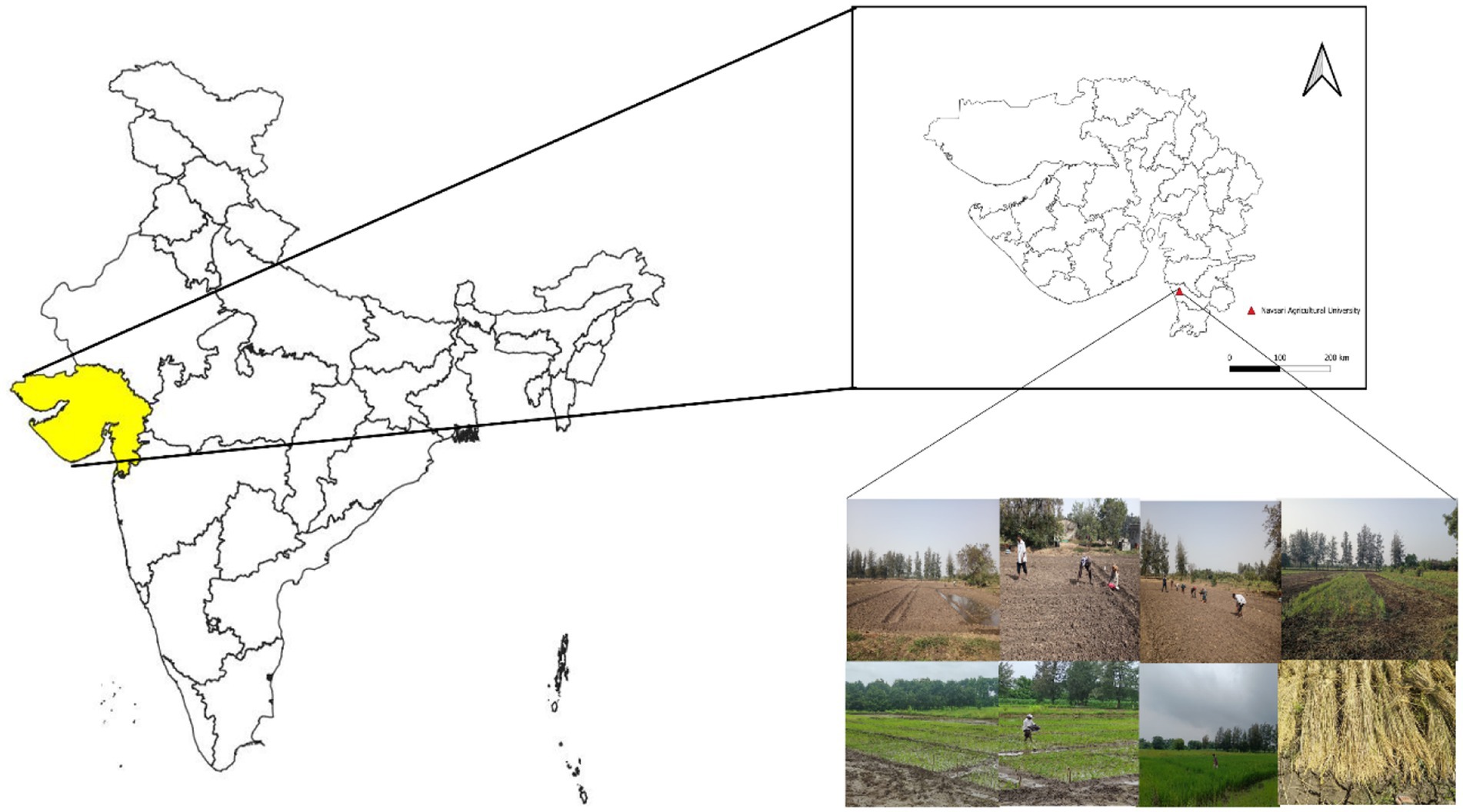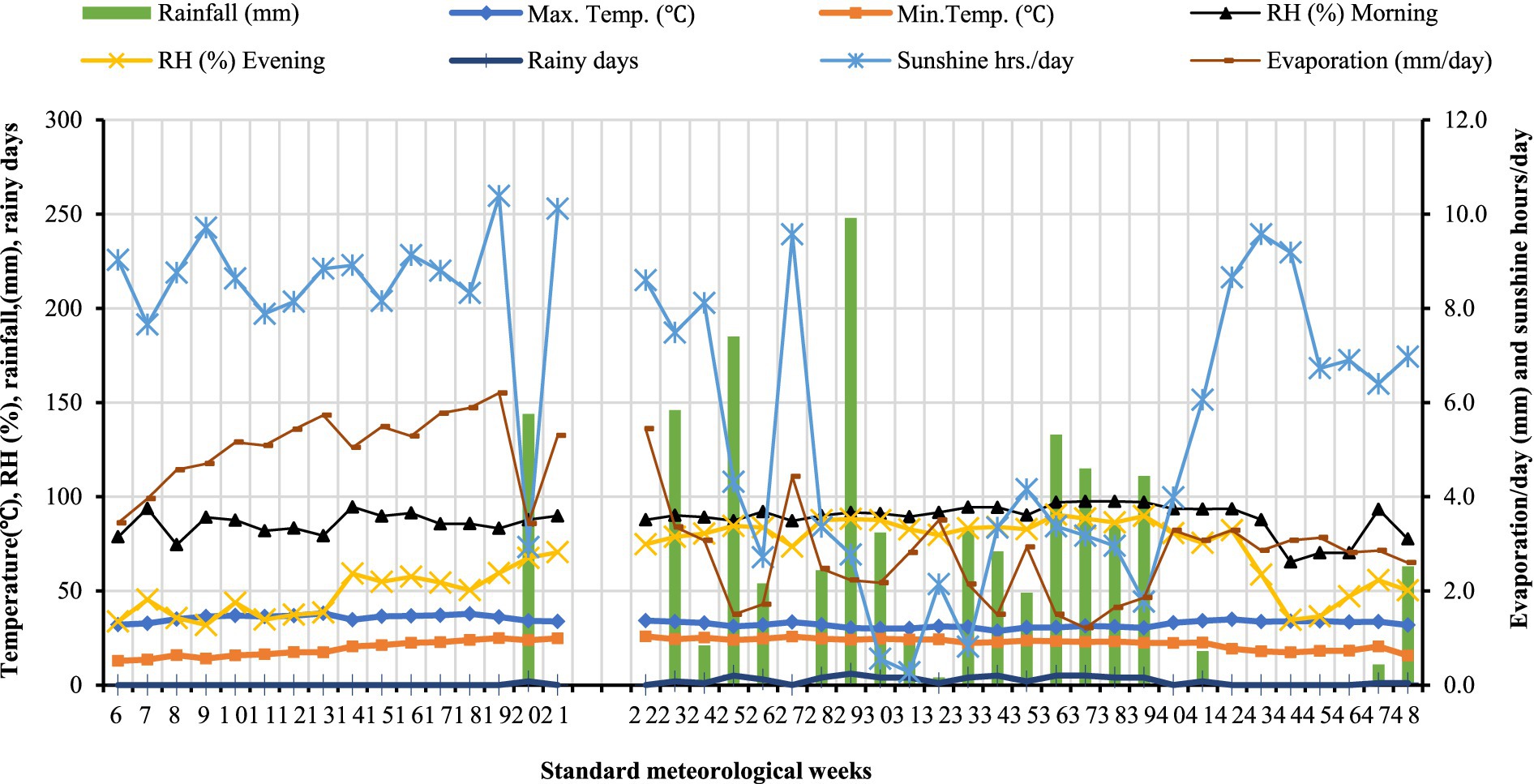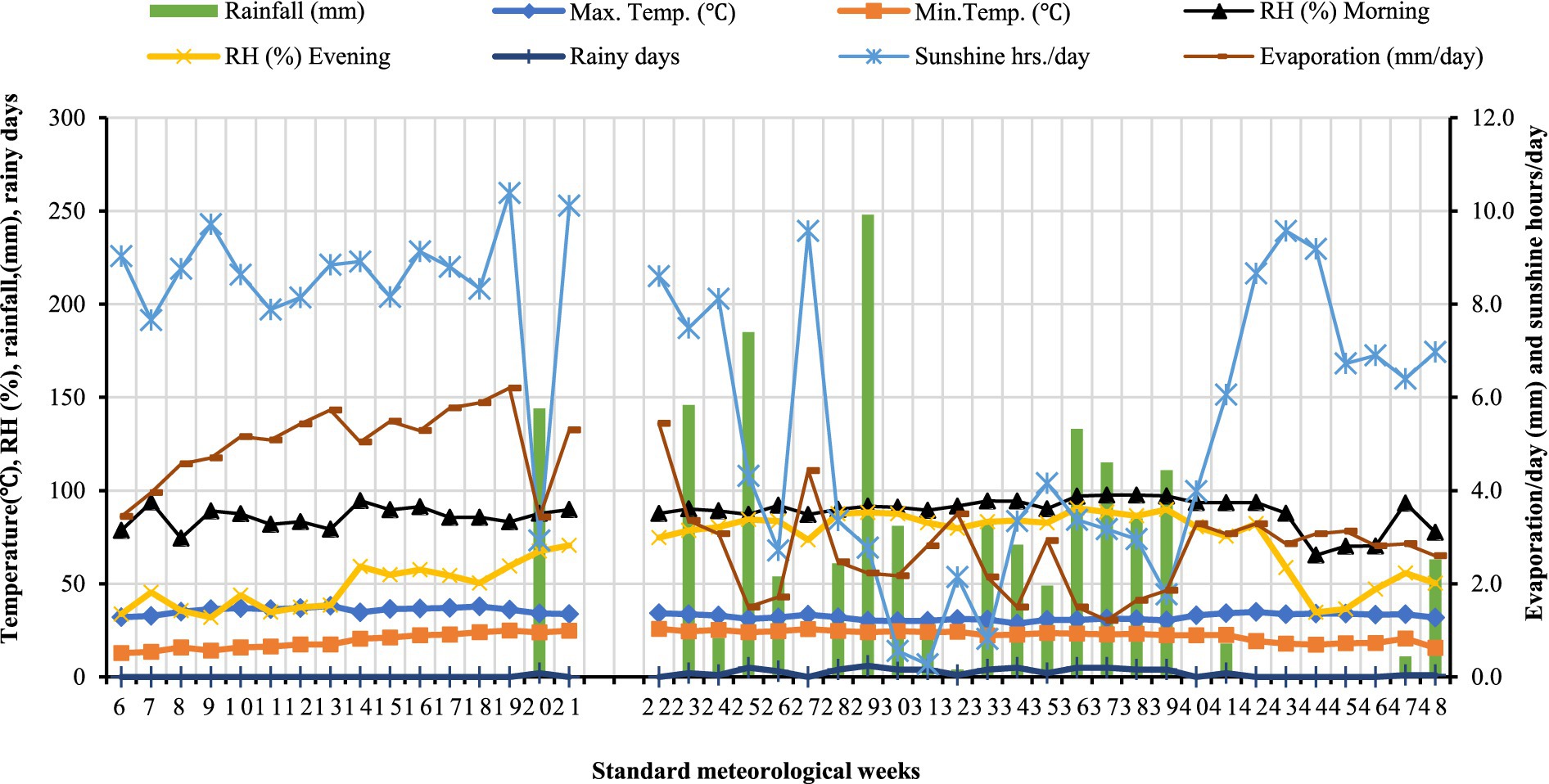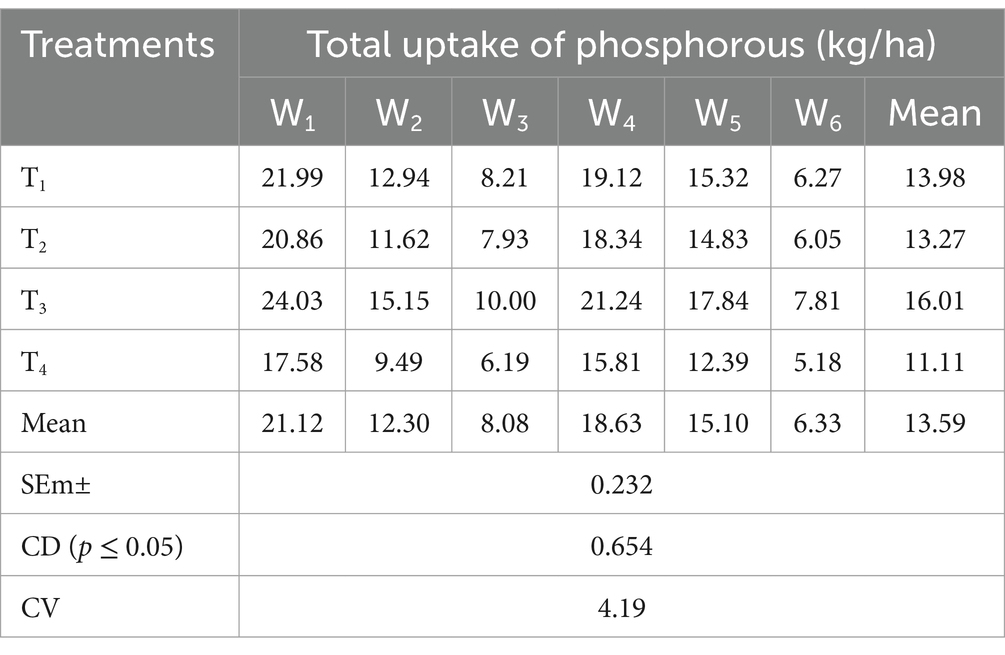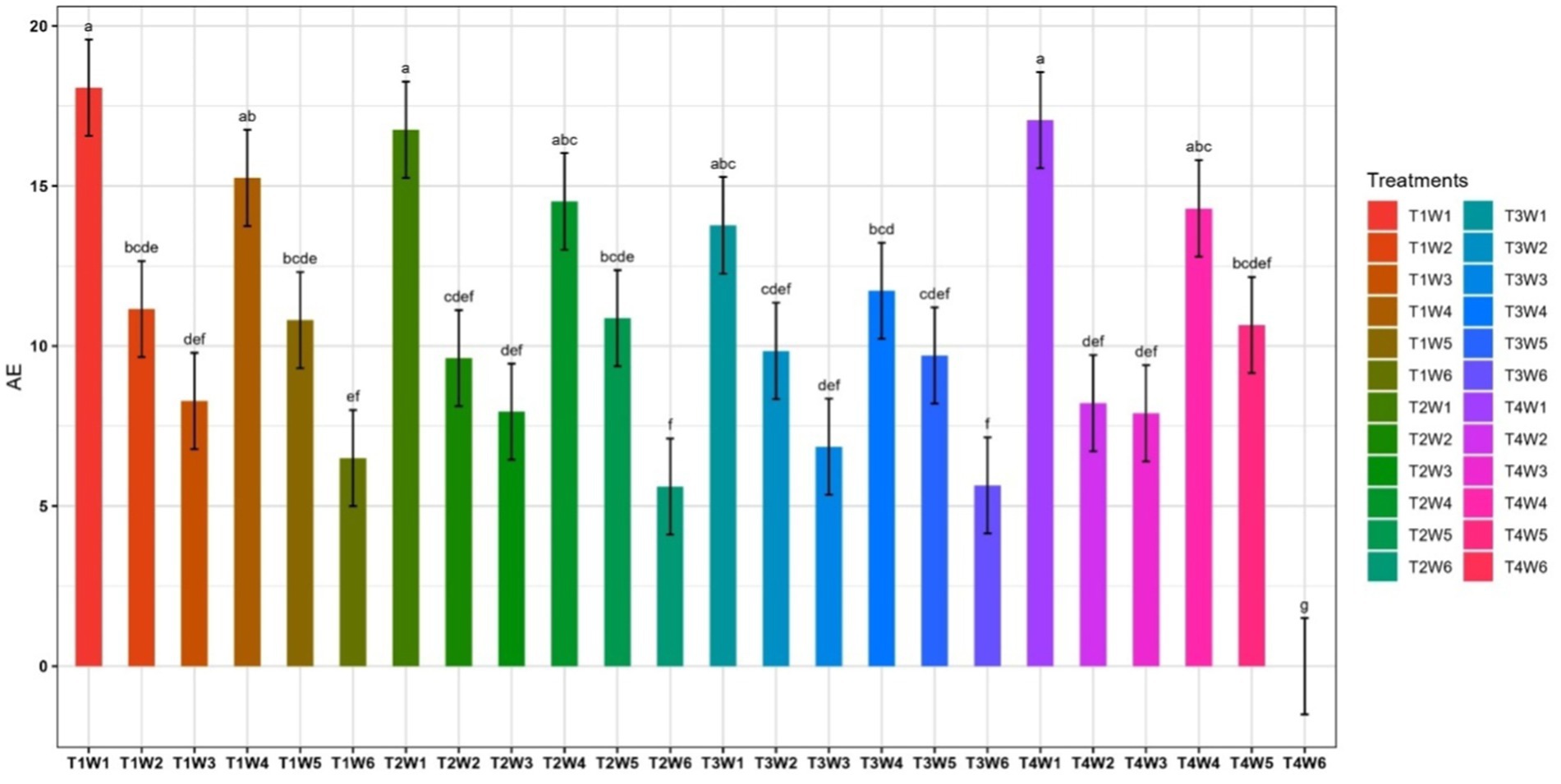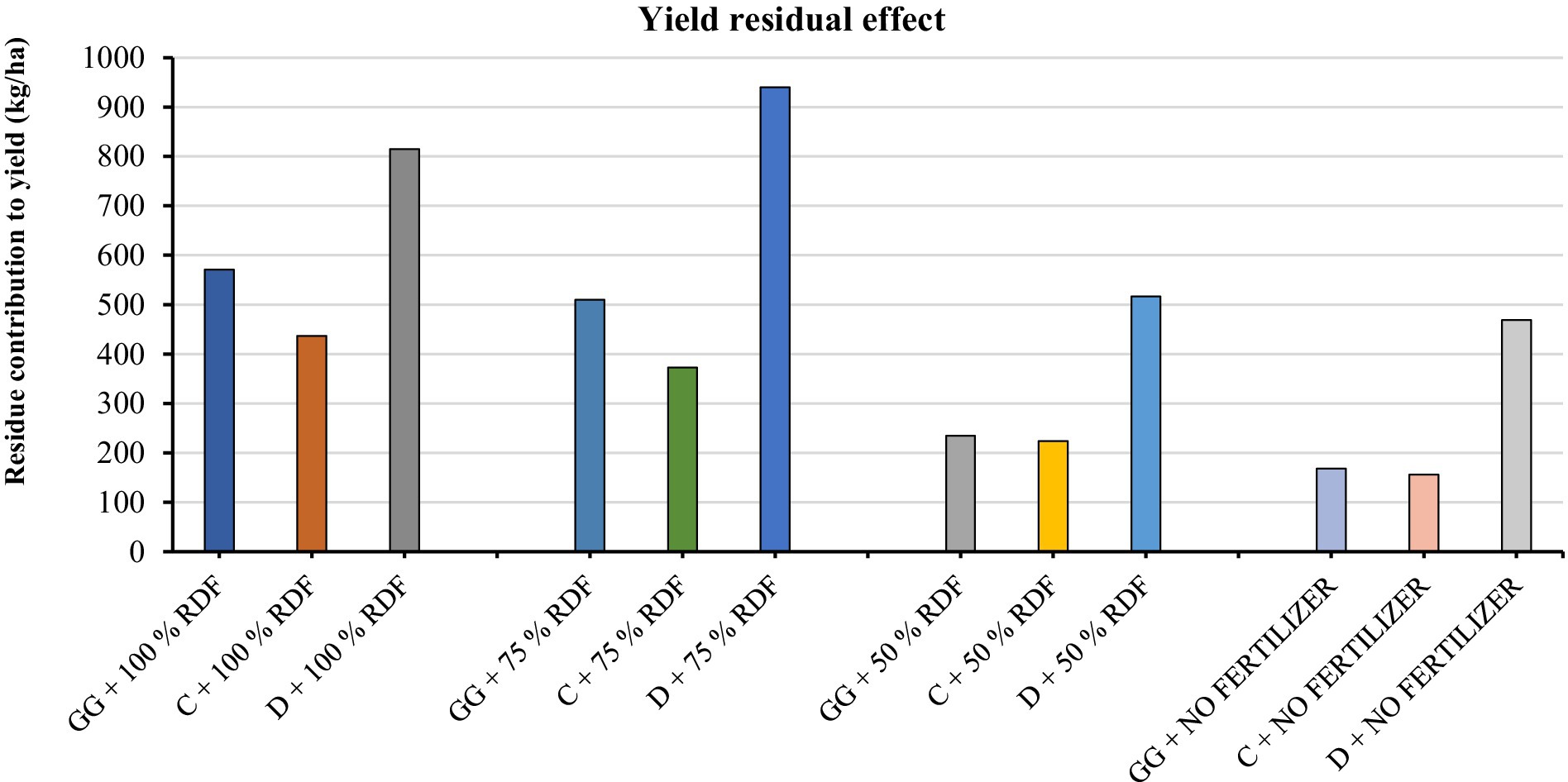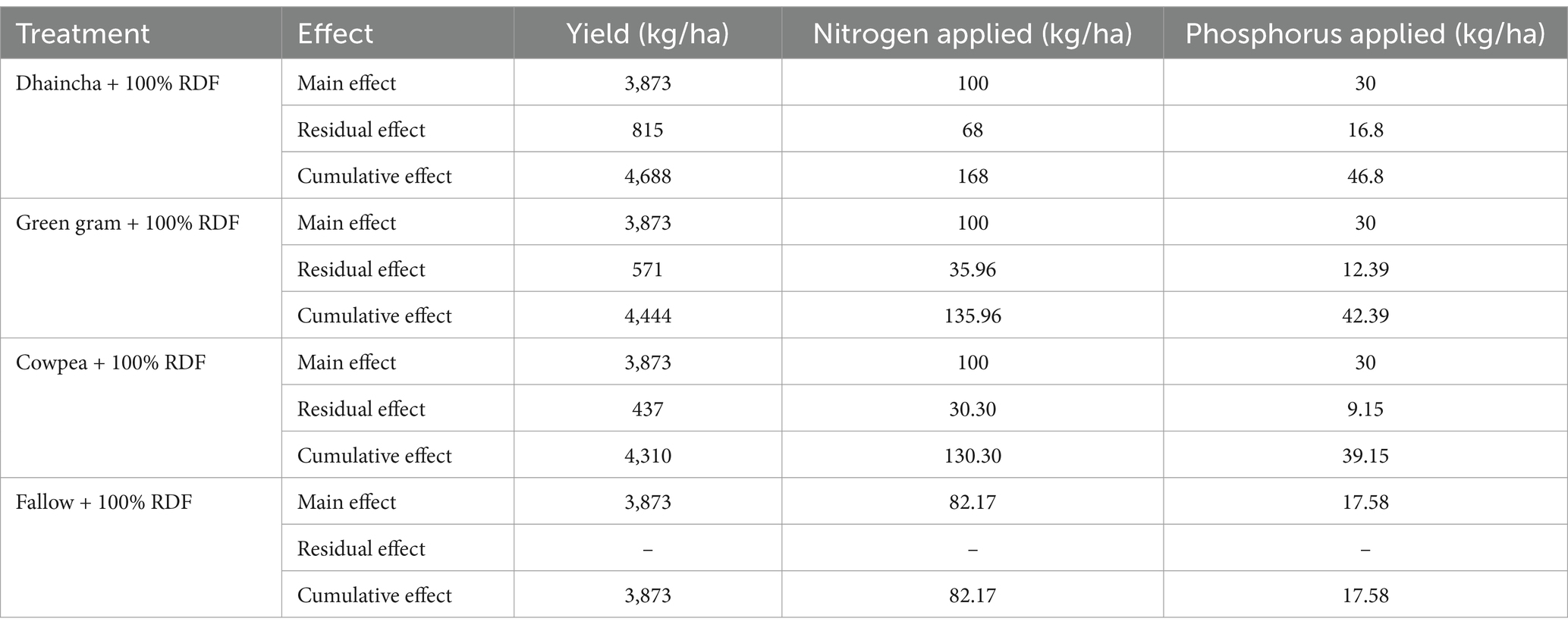- 1Department of Agronomy, N. M. College of Agriculture, Navsari Agricultural University, Navsari, Gujarat, India
- 2Department of Soil Science and Agricultural Chemistry, N. M. College of Agriculture, Navsari Agricultural University, Navsari, Gujarat, India
- 3Krishi Vigyan Kendra, ICAR-Central Institute of Agricultural Engineering, Bhopal, India
- 4Department of Soil Science and Agricultural Chemistry, School of Agricultural Sciences, Malla Reddy University, Hyderabad, India
- 5Department of Biotechnology, College of Science, Taif University, Taif, Saudi Arabia
- 6Agricultural Engineering Department, Faculty of Agriculture, Mansoura University, Mansoura, Egypt
- 7Civil Engineering Department, Faculty of Engineering, Minia University, Minya, Egypt
- 8Structural Diagnostics and Analysis Research Group, Faculty of Engineering and Information Technology, University of Pécs, Pécs, Hungary
- 9Agricultural Engineering Department, Faculty of Agriculture and Natural Resources, Aswan University, Aswan, Egypt
- 10Environmental Science in Environmental Science Department, Faculty of Science, Damietta University, Kafr Saad, Egypt
Sustainable nutrient management in rice-based cropping systems is essential to counteract soil degradation and excessive fertilizer dependence. Legume residue incorporation has been proposed as a strategy to improve soil fertility and nutrient use efficiency (NUE), yet its effectiveness under varying fertilizer regimes remains inadequately explored. A field experiment was conducted with four main treatments, i.e., green gram (Vigna radiata), cowpea (Vigna unguiculata), dhaincha (Sesbania aculeata), and fallow combined with six fertilizer regimes in subplots, i.e., 100% RDF (100 kgN + 30 kg P2O5 + 00 K2O kg/ha), 75% RDF (75 kg N + 22.5 kg P2O5 + 00 K2O kg/ha), 50% RDF (50 kg N + 15 kg P2O5 + 00 K2O kg/ha), 75% RDF + 25% N from FYM, 50% RDF + 50% N from FYM, and No-fertilizer application. This study evaluated the effects of legume residue incorporation on soil nutrient status, total nitrogen (N), phosphorus (P) and potassium (K) uptake, and NUE in kharif rice over 2 years and concluded that rice grown in dhaincha-incorporated plots exhibited significantly higher total NPK uptake, improved soil nutrient status, and enhanced NUE, followed by green gram and cowpea. The highest nitrogen and phosphorus recovery was observed in green gram plots under 100% RDF, while fallow plots with no fertilizer application recorded the lowest nutrient uptake and efficiency. Nitrogen use efficiency, agronomic use efficiency was found higher in dhaincha incorporated plots applied with 100% RDF. Preceding summer legumes with residue incorporation could result in nitrogen economy for succeeding kharif, as it responded more in 100% RDF + dhaincha incorporation but at par with dhaincha + 75% RDF + 25% N from FYM. Incorporating dhaincha residues reduced synthetic fertilizer requirements by 20–25%, demonstrating its potential to enhance soil fertility while reducing dependency on chemical inputs.
1 Introduction
Rice is one of the most important food crops contributing to food and nutritional security (Ladha et al., 2022). More than half of the global population cultivating rice making it the third most important crop after sugarcane and maize (Balakrishnan et al., 2024). Asia leads global rice production, accounting for 220 million tonnes (28%) of the total 780 million tonnes (FAO, 2018). The estimates for rice area, production, and productivity are 46.38 Mha, 130.29 MT, and 2.8 t/ha (Agricultural Statistics at a Glance, 2022). Improving fertilizer use efficiency is crucial for enhancing rice productivity and ensuring long-term soil health (Mahajan et al., 2017). Conventionally crops only utilize 30–40% of the nutrients they receive, and various processes like surface runoff, leaching, volatilization, denitrification, soil erosion, and soil fixation lead to the loss of the remaining nutrients. Less than 20 and 50%, respectively, are the average recovery efficiencies for P and N. Reduced organic matter increases nutrient inadequacies; a two-thirds reduction in organic matter indicates a significant reduction in nutrient availability (Stangel, 1991). An over-reliance on chemical fertilizers linked to soil salinization, poor physical and chemical properties, reduced soil microorganisms and declined productivity (Hepperly et al., 2009; Singh, 2000; Bhattacharyya et al., 2015).
To address these, integrated nutrient management system (INM) delivers a balanced nutrient supply by utilizing both organic and chemical sources supporting the sustained fertility (Walia et al., 2024). Organic fertilizers, overlooked for their slow release and limited availability (Geng et al., 2019) now recognized to improve rhizosphere microbes in rice (Ye et al., 2020) partial replacement of inorganic fertilizers (Pan et al., 2022; Puli et al., 2016), elevated micronutrient levels in the soil (Pandey and Verma, 2007). Singh and Kumar found increased production and nutrient usage efficiency in rice with organics. Pulse-based systems demonstrated superior accessible nitrogen (8–29%), phosphorus (3–35%), and sulfur (3–13%) compared to rice-wheat systems (Nath et al., 2023). Two weeks post green manuring using Macuna pruriens, soil-accessible nitrogen significantly increased (Maobe et al., 2011). Dhaincha (Sesbania aculeata) significantly accumulated readily available nutrients (NPK and Zn) in the soil (Pooniya and Shivay, 2012).
Strategies like residue incorporation can enhance soil health and nutrient use efficiency (Stagnari et al., 2017). Legumes incorporation support the physical soil environment, the restoration of organic matter (Islam et al., 2024), some varieties seem to reduce the amount of nitrate in the soil profile and increase the activity of soil microbes (Rani et al., 2022; Ghosh et al., 2007). Low C:N legumes break down and accelerate the process of N mineralization in the soil, supplying nutrients to subsequent crop (Zhou et al., 2019). By minimizing N loss, dhiancha in a rice cropping system can complement 50–100% artificial N fertilizer (Naher et al., 2019). After picking pods, the entire summer green gram/black gram plant was incorporated into the soil, resulting in the economization of rice in the rice-wheat system (40–60 kg N/ha, 30 kg P2O5, and 15 kg K2O per ha). Similarly, 6–8-week-old dhaincha accumulate about 3.4 t/ha dry matter and 100–120 kg N/ha (Balaji et al., 2023). In situ incorporation of green manure increased agricultural output while reducing the need for chemical fertilizer applications mitigating degradation (Lou et al., 2011; Nawaz et al., 2017; Xia et al., 2018; Yang et al., 2019). Incorporating summer legumes enriches soil fertility by enhancing nitrogen fixation, organic matter decomposition, and microbial activity, leading to improved nutrient availability and higher nutrient use efficiency in kharif rice while reducing reliance on synthetic fertilizers (Kaur et al., 2018; Sunil Kumar et al., 2024; Zhao T. et al., 2024). Synergistic application of inorganic fertilizers and organic manures and residue incorporation significantly increased the microbial biomass carbon (MBC), soil organic carbon and soil fertility (Guo et al., 2015; Singh et al., 2008; Baishya et al., 2015; Yadav and Meena, 2014).
To evaluate the residual effect of legumes, a formula-based computation was performed using an apparent recovery approach. Only the use of radioactive tracers or a comparable approach, not regular testing, allows for the assessment of the true recovery of the applied fertilizers. Despite being an advanced technological tool (Russel and Ginn, 2004), only properly equipped research sites can employ tracers. Thus, the so-called “apparent” recovery of nutrients supplied by fertilizers is computed for more realistic scenarios. The apparent recovery ratio is a straightforward method that assesses the apparent recovery efficiency of a nutrient by measuring the difference in nutrient uptake between plots receiving nutrients and those devoid of nutrients. The outcome is a percentage of the nutrient administered at the commencement of that particular time interval (Karklins and Antons Ruza, 2015). The ratio of nutrient uptake in the fertilized treatment is determined by dividing the nutrient absorption in a plot without nitrogen by the nutrient uptake in a plot with fertilization, represented as a percentage. The proportion of nutrients absorbed and obtained from the applied fertilizer remains unverified, so it is referred to as “apparent” recovery of fertilizer nitrogen (Rao et al., 1992). It is sometimes presumed that crops require an identical quantity of nitrogen regardless of the presence of external sources (fertilizers). Low nutrient use efficiency in Indian rice systems may be due to over-reliance on nitrogen fertilizers, poor application methods and water management and degraded soil health and organic matter, NUE can be improved by balanced fertilization and precision tools such as LCC, SSNM, advanced fertilizer technologies such as nano fertilizers and slow release fertilizers, water smart technologies and sustainable soil management such as biofertilizers, organic amendments (Govindasamy et al., 2023; Hu et al., 2023).
The study novelty presents in situ incorporation of summer legume residues (green gram, cowpea, dhaincha) into soil under varying fertilizer regimes with objective to assess the impact of incorporating summer legume residues on soil nutrient status and nutrient use efficiency in kharif rice. The hypothesis of the study was incorporating summer legume residues will significantly exhibit higher nutrient uptake and NUE compared to rice grown in legume residue incorporation compared to fallow treatments. In this context, this article aims to provide a basic analysis of the role of legume incorporation in succeeding in kharif rice in terms residual effect and nutrient use efficiency by traditional approaches.
2 Materials and methods
2.1 Study site description
This study was conducted from 2021 to 2022 at the College Farm of Navsari Agricultural University, Navsari (Gujarat), India. The site is located at 20.9248°N latitude and 72.9079°E longitude at an altitude of 11.98 m (Figure 1). Physiographically, the area lies in the coastal plains of South Gujarat, characterized by nearly level to gently sloping terrain, with moderate drainage and medium to deep alluvial soils. The region is part of the sub-humid agro-ecological zone, influenced by the Arabian Sea, contributing to high humidity and seasonal monsoonal rainfall (Keniya et al., 2024). The weekly rainfall during the kharif season ranged from 0.0 to 248 mm and 0.0 mm to 517 mm in 2021 and 2022, respectively. In both years, the rainfall began in June and concluded in September. The mean annual rainfall and temperature during the research period was 248 mm and 24°C during 2021, 345 mm and 22°C during 2022, as depicted in Figures 2, 3, respectively. The soil taxonomy of the experimental site was classified under soil order “Inceptisols,” and soil series “Jalapor.” He initial soil physico-chemical properties were mentioned the Table 1.
2.2 Field experiment design
The experiment was carried out in two seasons (viz., summer and kharif seasons) for 2 years, 2021 and 2022, in split-plot design with three replications. The treatment on the main plot was summer legumes (T) sown in summer season with four legumes viz., T1: Green gram (Vigna radiata), T2: Cowpea (Vigna unguiculata), T3: Dhaincha, and T4: Fallow. In sub plots, there were six nutrient management practices (W) viz., W1: 100% RDF (100 kgN + 30 kg P2O5 + 00 K2O kg/ha), W2: 75% RDF (75 kg N + 22.5 kg P2O5 + 00 K2O kg/ha), W3: 50% RDF (50 kg N + 15 kg P2O5 + 00 K2O kg/ha, W4: 75% RDF + 25% N from FYM, W5: 50% RDF + 50% N from FYM, and W6: No-fertilizer application. The main plot treatments, i.e., green gram and cowpea) were incorporated into the soil after the crop harvest, whereas dhaincha was incorporated into the soil at 50 % blooming stage aimed at optimizing nutrient cycling, decomposition rate, and nitrogen use efficiency (NUE) for the succeeding rice crop and their respective biomass, straw yield and nutrient content were mentioned in Tables 2, 3 (amount of biomass we have incorporated and the respective nutrient we have supplied through the summer legumes). A cropping sequence involving the cultivation of summer legumes green gram (Vigna radiata), cowpea (Vigna unguiculata), and dhaincha (Sesbania aculeata) was grown during the summer season, followed by transplanted rice (Oryza sativa) in the kharif season, with the land left fallow during the rabi season. This sequence was repeated on the same field in the subsequent year. After incorporation of the residues each main plot (summer legumes) was divided into six sub-plots and in each subplot rice crop of variety GNR-3 was grown with different nutrient management practices. Farmyard manure (FYM) was applied 15 days prior to rice transplanting. Inorganic fertilizers (NPK) were administered based on treatment protocols: phosphorus was applied entirely as a basal dose, nitrogen was split across basal, tillering, and at panicle initiation stages, while potassium was applied at basal and panicle initiation. Biomass from summer legumes (green gram, cowpea, and dhaincha) was incorporated into the soil post-harvest, allowing a one-month decomposition period before rice cultivation. Treatments with 100, 75, and 50% of the recommended NPK levels were applied to evaluate whether the added residue could help make up for the reduced fertilizer in the lower NPK treatments. This approach was used to assess the potential of the residue to partially replace chemical fertilizers. Straw incorporation was employed as a strategy to enhance soil fertility by supplementing inorganic nutrient inputs. After harvesting green gram and cowpea, residual biomass was incorporated into the soil through ploughing. In the case of dhaincha, biomass was incorporated at 50% flowering, followed by irrigation to facilitate decomposition. The chemical and other composition details in the experiment is given in Tables 2–5.

Table 5. Nutrient status prior to the sowing of kharif rice and immediately following the harvest of summer legumes (at the time of incorporation).
2.3 Methods of soil and plant analysis
Soil samples were collected at the initiation of the experiment, after the soil fertility gradient stabilizing experiment, before and after the test crop experiment, and the verification trial experiment and analyzed for pH and EC (Jackson, 1973), organic carbon (Walkley and Black, 1934), available nitrogen (Subbiah and Asija, 1956), Olsens extractable phosphorus (Bray and Kurtz, 1945), and neutral normal ammonium acetate potassium (Knudsen et al., 1982), respectively. Nutrient content in grain and straw were obtained by total nitrogen by the modified Micro Kjeldhal method (Bremner, 1996), phosphorus by the vanadomolybdophosphoric yellow method (Morre, 1991), and potassium by the wet digestion method (Chapman and Brown, 1950), respectively. Nutrient absorption by grain and straw was calculated by multiplying grain yield (kg ha−1) by nutrient concentration in the grain (%) and straw yield (kg ha−1) by nutrient concentration in the straw (%), respectively. The total nutrient uptake by the crop is the sum of nutrient absorption in the grain and the straw.
2.4 N, P2O5, and K2O uptake
The nutrient (NPK) uptake (kg/ha) of pods, grain and stover/straw of summer legumes (green gram, cowpea, dhaincha) and rice was worked out by using Equation 1, according to (Sunil Kumar et al., 2024).
2.5 Nutrient use efficiencies
The agronomic, physiological and apparent recovery efficiencies were estimated by using Equations 2–4 as stated by Congreves et al. (2021) and Sarkar et al. (2021).
where, = Grain yield (kg/ha) with applied nutrient; = Grain yield (kg/ha) with no applied nutrient, = Total nutrient uptake (kg/ha) with applied nutrient; = total nutrient uptake (kg/ha) with no applied nutrient.
On the other hand, the Partial factor productivity, nutrient efficiency ratio, and nutrient addition through straw, were calculated according to Equations 5–7.
2.6 Residual effect of summer legumes
The residual effect of summer legumes was approximately calculated based on yield and total uptake data obtained in the field experiments. Apparent recovery ratio was used as a tool to calculate nitrogen and phosphorus accumulation (residual effect). The proportion of nitrogen/phosphorus absorbed and derived from the applied nitrogen/phosphorus cannot be verified; thus, it is referred to as “apparent” nutrient recovery. The residual effect and absolute residual effect were calculated using Equations 8, 9.
where, A = Yield from residue incorporated plot with fertilizer, B = Yield from residue free plot with fertilizer, and C = Yield in residue free plot without fertilizer.
2.7 Statistical analysis and interpretation of data
The statistical procedures outlined by Panse and Sukhatme (1967) were employed to analyze the data on a variety of variables. The ‘F’ test was implemented to compare the treatment effects on all the characters under investigation. The mean values of the summer legumes were presented, and the subsequent kharif rice was analyzed using a Split Plot Design. In the event that the ‘F’ test revealed significant differences among the interventions, the Critical Difference (CD) at 5% was calculated. Otherwise, the standard error of the mean was computed. Pooled analysis of the summer legumes and succeeding kharif rice analysed for two years was worked out as per the method described by Cochran and Cox (1957). Bertlett’s test was applied to examine the homogeneity of variance due to error.
2.8 Pooled analysis
The fundamental method of variance analysis may not be suitable for two distinct seasonal conditions, as the error variances between seasons and the treatment × season interaction could be substantial. Consequently, the method outlined by Cochran and Cox (1957) was employed to conduct an aggregated analysis of the summer legumes and subsequent kharif rice over a two-year period. The homogeneity of variance attributable to error was evaluated using Bartlett’s test. The presence or absence of a season × treatment interaction was determined by comparing the variance resulting from the season × treatment components to the pooled estimate of error variance.
3 Results
3.1 Available soil nutrient status
3.1.1 Organic carbon
Organic carbon status (Table 6) was found highly significant in dhaincha incorporated plots (0.76%), showing a 5.56% increase compared to the fallow treatment (T4, 0.72%). Whereas, cowpea incorporated plots (T2, 0.75%) exhibited a 4.17% increase over fallow, and were statistically at par with green gram incorporated plots (T3, 0.74%), which showed a 2.78% increase compared to fallow plots. The highest organic carbon content (0.77%) was recorded with application of 50% RDF + 50% N through FYM and 75% RDF + 25% N from FYM, both of which were at par with each other and showed an increase of 10% over unfertilized plots (0.70%). However, the response remained consistent across interactions and years, indicating that the organic carbon status has remained stable.
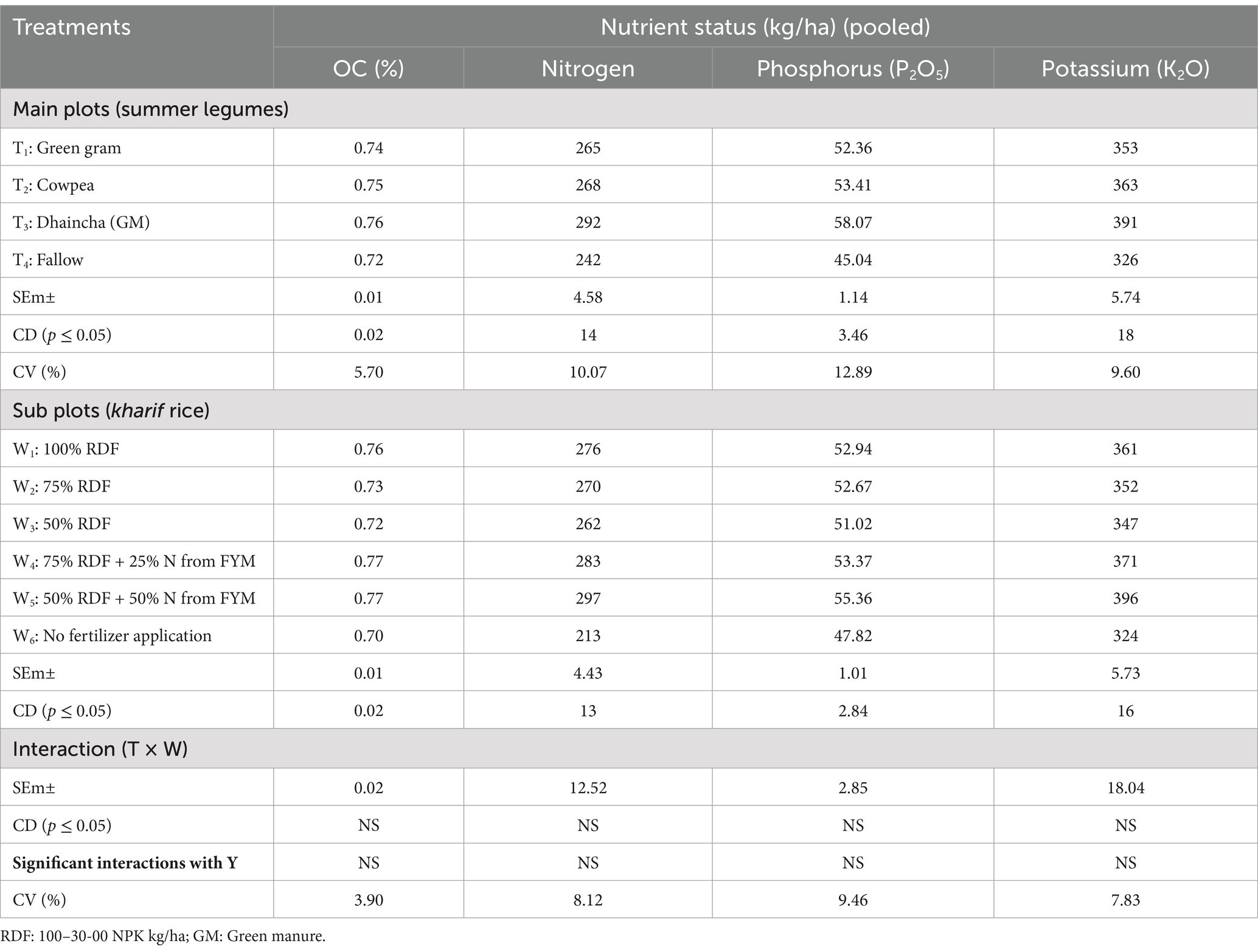
Table 6. Nutrient status of the soil after harvest of kharif rice as influenced by different treatments.
3.1.2 Available nitrogen
Dhaincha incorporated plots have significantly higher available nitrogen status with 8.96% increase over cowpea incorporated plots and 20.66% increase over fallow, whereas significantly higher available nitrogen was recorded with application of 50% RDF + 50% N through FYM, with 4.95% increase over W4 and 39.44% increase over W6. A two-year study (Table 6) revealed that significantly higher available nitrogen was noted with incorporation of dhaincha (292 kg ha−1). Whereas significantly highest available nitrogen (297 kg ha−1) with application of 50%RDF + 50% N through FYM. The year x treatment interactions was non-significant, indicating summer legume incorporation and nutrient management practices were consistent across years.
3.1.3 Available phosphorus
A pooled study (Table 6) for 2 years revealed that, highest soil available phosphorus was recorded in dhaincha incorporated plots (58.07 kg/ha) with 28.96 percent increase over fallow. Application of 50% RDF + 50% N through FYM (55.36 kg ha−1) has showed significantly higher soil available phosphorus with 3.73 percent increase over W4 and 15.77% increase over W6. The non-significant interaction between summer legume incorporation and nutrient management practices along with year, suggested a stable phosphorus.
3.1.4 Available potassium
Significantly highly available potassium (Table 6) was noted with incorporation of dhaincha (391 kg ha−1) with 7.71% over T2 and 19.94% over fallow. Whereas significantly highest available potassium (396 kg ha−1) was recorded with application of 50% RDF + 50% N through FYM with 6.74% over W4 and 22.22% over W6. The preceding incorporation of dhaincha has a significant effect on available K2O content of soil (kg/ha) after the harvest of rice with maximum available K2O content of soil as 391 kg/ha. Application of 50% RDF + 50% N through FYM has shown significantly higher potassium. Non-significant with year, suggested a stable potassium.
3.2 Total uptake of nutrients
From the pooled analysis, significantly higher total nitrogen uptake was noticed in rice grown in dhaincha incorporated plots (T3, 80.88 kg ha−1) with 37.43% increase over fallow. Whereas, the application of 100% RDF (W1) exhibited significantly higher nitrogen uptake (97.09 kg ha−1) with 121.73 percent increase over W6. The interaction effect was found to be significantly with highest total nitrogen uptake recorded in dhaincha incorporated plots along with application (109.29 kg/ha) with over a 113.39 percent increase over absolute control, which it remained consistent for 2 years (Table 7).
Rice sown after incorporation of dhaincha recorded significantly higher total phosphorus uptake (16.01 kg ha−1) with 44.08 increases over fallow treatment. Application of 100% RDF has shown significantly higher total phosphorus uptake (21.12 kg/ha) with 233.65 percent over W6. Interaction effect i.e., dhaincha incorporation along with 100%RDF as 24.03 kg ha−1, and the interaction effect with year was found to be non-significant (Table 8).
Pooled analysis results revealed that incorporation of dhaincha recorded significantly higher potassium uptake (100.04 kg ha−1) with 39.06 percent increase over fallow. Among the nutrient levels applied to rice crops, significantly the highest total potassium uptake by rice (111.61 kg/ha) was found with 100% RDF with 95.72 percent increase over control. Interaction effect of dhaincha incorporation along with 100%RDF was found significant (129.38 kg ha−1) with 166.01 percent increase over absolute control, but interaction with year was consistent over 2 years (Table 9).
3.3 Agronomic use efficiency
Pooled analysis revealed that significantly highest agronomic use efficiency (kg grain/kg N applied through fertilizer + FYM) of rice crop was noted with dhaincha incorporation. In sub plots, the agronomic use efficiency of rice crops was significantly highest in 100%RDF. The interaction effect was found to be non-significant with highest obtained in treatment dhaincha + 100% RDF, which was found to be efficient in using nitrogen with agronomic use efficiency of 25.20 kg grain/kg N applied as depicted in Figure 4 and it remained consistent throughout 2 years. Nutrient applied through fertilizer and FYM was mentioned in Table 10.
3.4 Nitrogen use efficiency (fertilizer + FYM + residue)
The nitrogen use efficiency of rice in the study was expressed in terms of grain yield, i.e., (kg grain/kg N applied through fertilizer + FYM + residue) presented in Table 11. Among the different summer legumes, the highest nitrogen use efficiency (11.68 kg grain−1 kg−1 N applied through fertilizer + FYM + residue) of rice crop was registered with green gram incorporation and it is statistically at par with cowpea, dhaincha and summer fallow.
Nitrogen use efficiency of rice crops was significantly highest (16.41 kg grain/kg N applied through fertilizer + FYM + residue) in the treatment that received 100% RDF (W1) and percent increase over W6 was 269.59 percent. However, during the experimentation, the treatment of 75% RDF + 25% N from FYM (W4) was at par with 50% RDF + 50% N from FYM (W5) in the pooled study.
3.5 Nitrogen and phosphorus apparent recovery ratio (ARR)
Rice grown in green gram-incorporated plots recorded significantly higher ARR-N (Figure 5) as depicted in 4,688 kg/ha 34.60%, Whereas ARR-P was not significant, but higher ARR-P was found with incorporation of green gram Significantly higher ARR-N (%) in rice was noticed in 100% RDF (45.72%, pooled basis) as denoted in Figure 5. The treatment 100% RDF (W1) recorded a 42.67% apparent recovery ratio of phosphorus during pooled studies (Figure 6). From the pooled analysis, it can be revealed that the interaction effect of summer legume incorporation along with nutrient application was found to be non-significant for ARR-N and noted as significant for ARR-P, respectively.
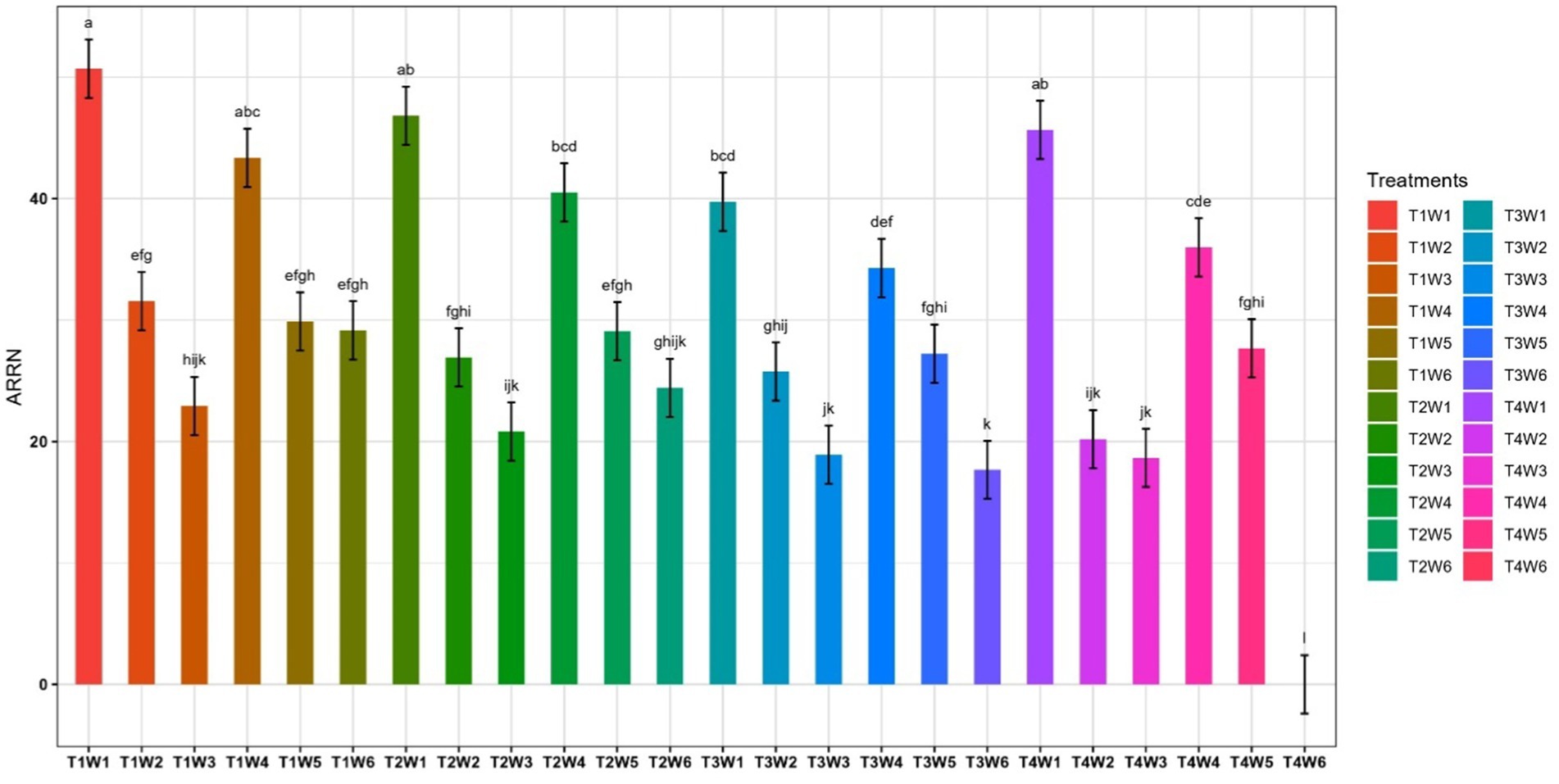
Figure 5. Apparent recovery ratio of nitrogen in kharif rice as influenced by treatments (pooled study).
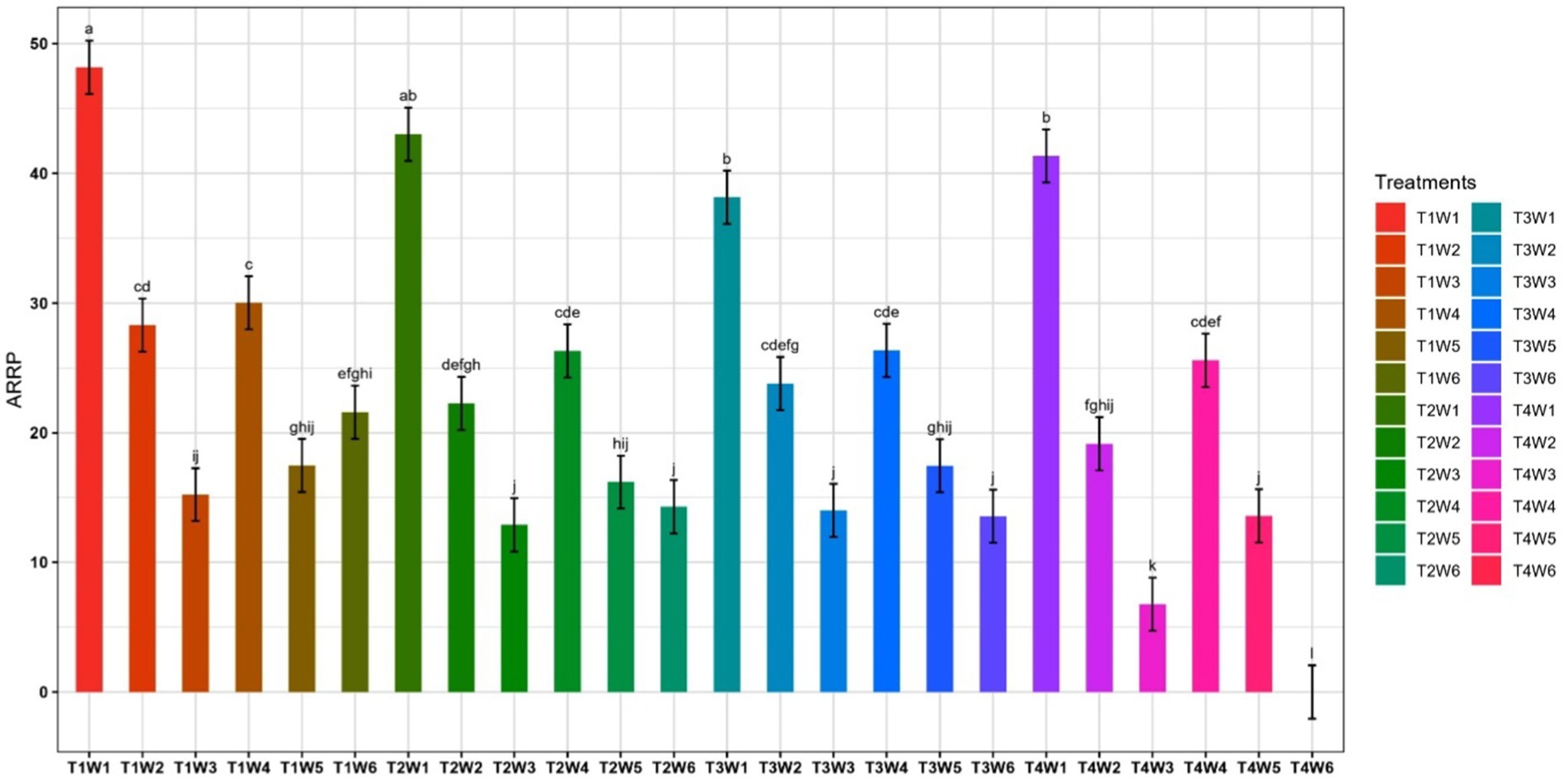
Figure 6. Apparent recovery ratio of phosphorous in kharif rice as influenced by treatments (pooled study).
3.6 Physiological efficiency
Summer legume-incorporated plots have no significant influence on physiological efficiency of rice (Figure 7). However, higher physiological efficiency was found in rice grown in dhaincha plots (34.83 kg kg−1). Higher physiological efficiency was found with the application of 50% RDF (W3, 38.24 kg kg−1), but it was statistically at par with W2, W5, W4, and W, which remained consistent for 2 years.
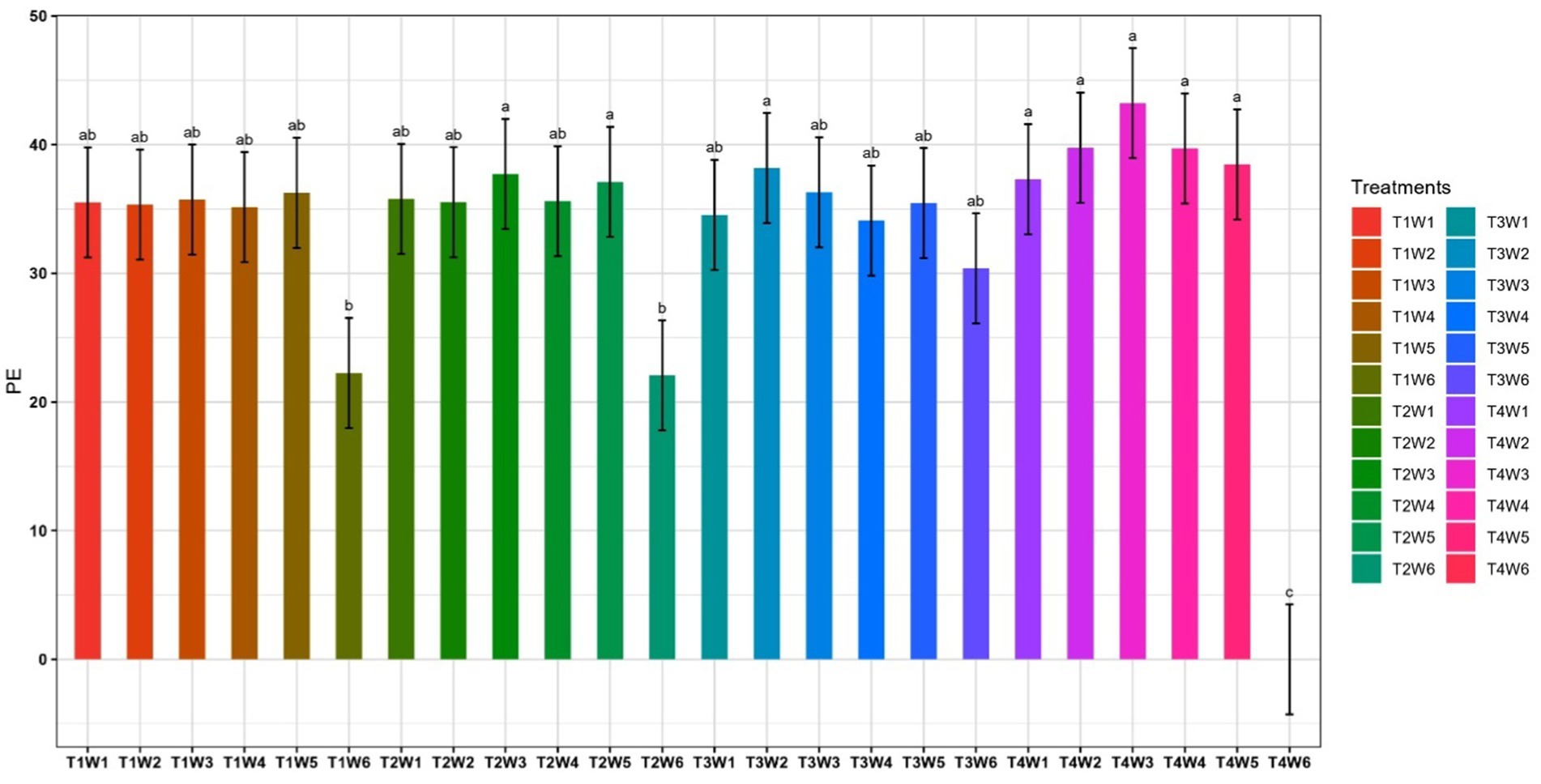
Figure 7. Physiological efficiency of kharif rice as influenced by treatments in kharif rice (pooled study).
4 Discussion
4.1 Soil available nutrient status
Significant variations in post-harvest soil N, P₂O₅, and K₂O levels were observed following summer legume incorporation and nutrient applications in kharif rice. Dhaincha, with its high nutrient content and rapid growth, outperformed other legumes, contributing significantly where N, P₂O₅, and K₂O become more available, underlining the critical role of legume incorporation in enhancing soil health, fertility, and overall ecosystem sustainability (Zhao N. et al., 2024). The plots that received 50% RDF + 50% N from FYM or 75% RDF + 25% N from FYM maintained soil fertility as effectively as 100% NPK treatments over 2 years and pooled data. The increase in soil nitrogen was linked to legume nitrogen fixation, residue incorporation, and fertilizer use. Phosphorus and potassium levels improved due to the breakdown of crop residues and organic matter, aided by inorganic fertilizers. The integration of FYM and inorganic fertilizers and green manure likely created favorable conditions for nutrient mineralization for increased accessible nitrogen and organic carbon enhancement (Sharma and Ghosh, 2000). Applying NPK along with organic manures (vermicompost, FYM, or green manure) significantly raised available phosphorus compared to NPK fertilizers alone, potentially due to the ability of organic inputs to complex cations that contribute to phosphorus fixation (Kamla et al., 2005; Bajpai et al., 2006). Organic acids released during green manure decomposition may have further boosted phosphorus availability (Alagappan and Venkitaswamy, 2016). Additionally, green manuring improved potassium availability through the release of exchangeable K during residue decomposition (Maiti et al., 2006; Upadhyay et al., 2011).
4.2 Plant nutrient uptake
Incorporating summer legumes significantly increased N, P, and K uptake in rice, with dhaincha showing the highest uptake due to its incorporation at 50% flowering, unlike green gram and cowpea, which were incorporated post-harvest. The decomposition of green manures improved soil conditions, enhancing root growth and nutrient absorption (Talathi et al., 2009; Saraswat et al., 2010; Islam et al., 2014, 2019). Rice uptake of N, P, and K was significantly higher when inorganic fertilizers were combined with organic manures compared to when no fertilizer was used (W6). The highest N uptake was observed with 100% RDF, followed by 75% RDF + 25% N from FYM and 50% RDF + 50% N from FYM, may be due to optimal nutrient balance and immediate nutrient availability and similar trend observed for P and K uptake across both years and in pooled analysis. This correlation aligns with dry matter accumulation and yield per hectare across treatments and improved nutrient availability (Sunitha et al., 2010; Kumar et al., 2012, and Kumari et al., 2013).
Fertilizer contribution (Figure 8) was more in total uptake of NP, followed by others. It is because of the readily available nature of fertilizers. But in the long run, due to the decomposition of crop residues, the nutrient availability may increase after complete decomposition. Tarafdhar et al. (2016) reported that FYM applied to the crop will be available by about 30% in the first year of application and the rest will be available in subsequent years. A considerable amount of N in FYM is lost during its preparation and storage, mainly as NH₃ volatilization and leaching. Hence, in this study, the treatments with FYM were efficient only after 100% RDF chemical fertilizer application.
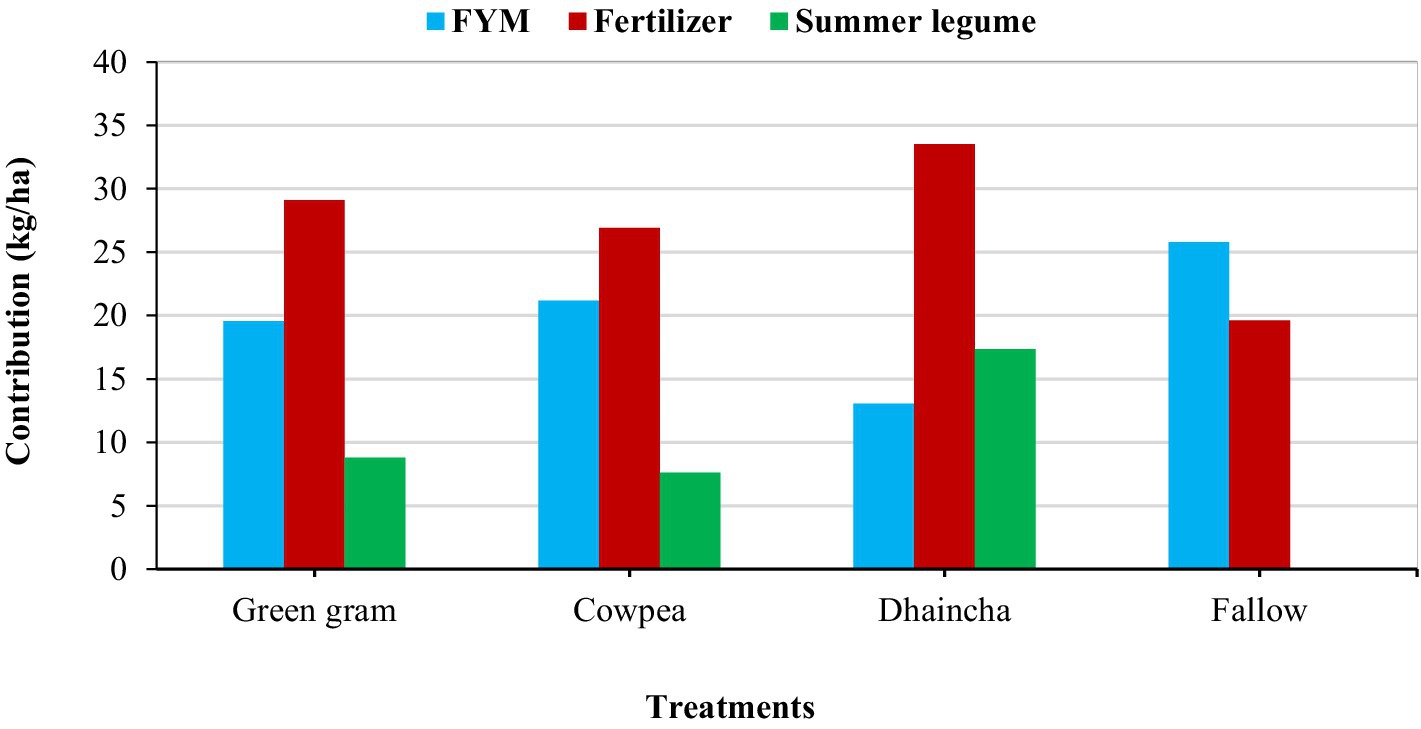
Figure 8. Contribution of sub plot treatments and different summer legumes toward total uptake as influenced by different treatments in kharif rice.
4.2.1 Nitrogen use efficiency (fertilizer + FYM + residue)
Results stated that increased nutrients through crop residue are found to decrease the nutrient use efficiency as they are not readily available to the crop. Hence, there was non-significant behavior in summer legumes, though higher biomass was applied through dhaincha, but NUE was higher in green gram. But in fertilizer treatments, 100% RDF was found significant. Therefore, we can predict that fertilizer use efficiency is higher than residues and FYM, as it was readily available to crops. Because of this condition, more yields were found in 100% RDF (W1) when compared to other treatments. These results align with the findings of Kouelo et al. (2013). The elevated nitrogen usage efficiency in the green gram-incorporated plot may result from green manure sequestering nitrogen in the soil during the early decomposition phase, minimizing nitrogen losses, and guaranteeing sufficient nutrient availability in the subsequent reproductive phases (Zhu et al., 2014). Furthermore, the low carbon-to-nitrogen ratio, which facilitates substantial atmospheric nitrogen fixation and enhances nitrogen availability, ultimately increases nitrogen use efficiency. As a leguminous green manure crop, it augments nitrogen supply through fixation, and the majority of green manure nitrogen residues in soils consist of organic nitrogen, which is not readily volatilized or leached (Meng et al., 2019). Comparable results were also documented by Song et al. (2022), Mangaraj et al. (2023), and Singh et al. (2024).
4.3 Agronomic use efficiency
The dhaincha crop has a higher biomass nutrient concentration when compared to other legumes whose incorporation has shown better nutrient availability, which enhanced the growth and yield of rice in treatments involving dhaincha incorporation, ultimately improving the agronomic use efficiency (Irin et al., 2019). Enhanced agronomic use efficiency due to dhaincha crop incorporation was also reported by Chen et al. (2018), Islam et al. (2019), Walia et al. (2024), and Thulasi et al. (2024).
4.4 Nitrogen and phosphorus apparent recovery ratio (ARR)
The apparent recovery ratio (%) of nitrogen varied from 17.67 to 50.69% during the pooled study. Among the summer legumes tested for incorporation, significantly higher ARR of nitrogen (50.69%) was found in green gram—100% RDF (T1W1) and it was followed by T2W1 (cowpea-100% RDF), and the lowest was found in T3W6 (17.67%) and T4W6 (0) in the pooled study (Figure 5). The data of ARR of phosphorus (Figure 6) showed that significantly higher ARR-P was found in the treatment when rice was grown in green gram incorporated plots with 100% application of fertilizer (T1W1) with ARRP of 48.17% during the pooled study. and the lowest was observed in T4W3 (Fallow-50% RDF, 6.77), besides absolute control (0%, T4W6). The apparent recovery ratio of phosphorus varied from 6.77 to 48.17% in pooled. The higher ARR-N was found in green gram-incorporated plots with 100% RDF when compared to dhaincha-incorporated plots with 100% RDF. Even though dhaincha supplied a larger amount of biomass, green gram biomass decomposed and released nutrients in such a way that it correlated with the uptake requirement of the kharif rice crop, which might be the cause for better apparent recovery efficiency of nitrogen and phosphorus, respectively (Peoples et al., 2017). Similar findings were supported by Rani et al. (2022), Govindasamy et al. (2023), and Vaziritabar et al. (2024).
4.5 Physiological efficiency
Physiological efficiency (PE) indicates the effectiveness of nutrient accumulation and conversion from source to sink. In a pooled study, rice grown in dhaincha-incorporated plots achieved the highest PE (34.83 kg/kg), attributed to enhanced soil organic matter, nitrogen content, and microbial activity. Conversely, the lowest PE (33.08 kg/kg) was recorded in fallow plots, highlighting the role of green manuring in improving soil fertility (Figure 7). Among fertilizer treatments, the highest PE (38.24 kg/kg) was observed with 50% RDF (W3), although this was statistically comparable to other nutrient regimes (W2, W5, W4, W1). The absence of fertilizers (W6) resulted in the lowest PE (18.68 kg/kg), underlining the necessity of nutrient supplementation for optimal rice performance. The interaction of summer legumes and nutrient doses revealed that fallow plots with fertilizers yielded higher PEN, whereas legume-incorporated plots without fertilizers showed reduced efficiency (22.25–30.38 kg/kg). This suggests that while legume incorporation enhances soil fertility through nitrogen fixation and organic matter addition, it cannot entirely replace inorganic fertilizers. Instead, integrating legumes with moderate fertilizer application is more effective for optimizing PE. Overall, treatments involving summer legumes significantly outperformed the control (W6), reinforcing the synergistic benefits of green manuring and nutrient management for improved physiological efficiency in rice.
5 Residual effect of summer legumes on kharif rice
Data presented in Tables 13, 14 and Figures 9, 10 reveal Rice crop grown in dhaincha-incorporated plots have a better yield (4,688 kg ha−1). The rice grown in fallow plots with 100% RDF has a yield of 3,873 kg ha−1. This reveals that the extra yield of 815 kg/ha (4,688–3,873 = 815 kg/ha) recorded in rice grown in dhaincha-incorporated plots was due to the residual effect of residue incorporation of dhaincha before rice sowing as depicted in Figures 9, 10 and Tables 12–14. Similarly, it was noticed in green gram (4,310–3,873 = 571 kg/ha) and cowpea (4,310–3,873 = 437 kg/ha) incorporated plots. Nearly dhaincha incorporation has provided 68 kg/ha nitrogen and 16.8 kg/ha phosphorus extra to the succeeding rice crop, whereas for green gram and cowpea it was 35.96 and 30.30 kg/ha nitrogen and 12.39 and 9.15 kg/ha phosphorus to the succeeding kharif rice, respectively. This causes the yield to increase in incorporation treatments when compared to fallow treatments. The data also reveals that total uptake of phosphorus and nitrogen was also recorded in dhaincha-incorporated plots fed by green gram and cowpea because of the residual effect of incorporation. Hence, dhaincha, because of its higher residual effect, rice grown in dhaincha-incorporated plots recorded higher yield, uptake of NPK, and soil nutrient status. Incorporation of dhaincha with 75% RDF to rice yielded almost the same as of 100% RDF + fallow [(3,873×75)/100 = 2,904 kg ha−1]. In a similar way, dhaincha without fertilizer had given a yield of 2,636 kg/ha, and fallow + 100% RDF resulted in a yield of 3,873 kg ha−1, whereas dhaincha + 75% RDF yielded 3,724 kg ha−1, which was almost similar to the yield of 100% RDF. Hence, we can understand that dhaincha incorporation added nutrients and compensated for the chemical fertilizer, resulting in saving 20–25% of nitrogen and phosphorus (approximately). Incorporation of legume residues releases beneficial nitrogen for the subsequent crop through decomposition and mineralization while minimizing negative environmental impacts, thereby showing residual effect on the subsequent crop (Muschietti-Piana et al., 2020; Regassa et al., 2023). Incorporation of summer legumes might have deposited residues of nitrogen for steady release to the standing crop, which enhanced the economic as well as biological yield (Ammaji and Rao, 2020). Residual effects of summer legumes were also reported by Pathak et al. (2018) and Bharadwaj et al. (2023).
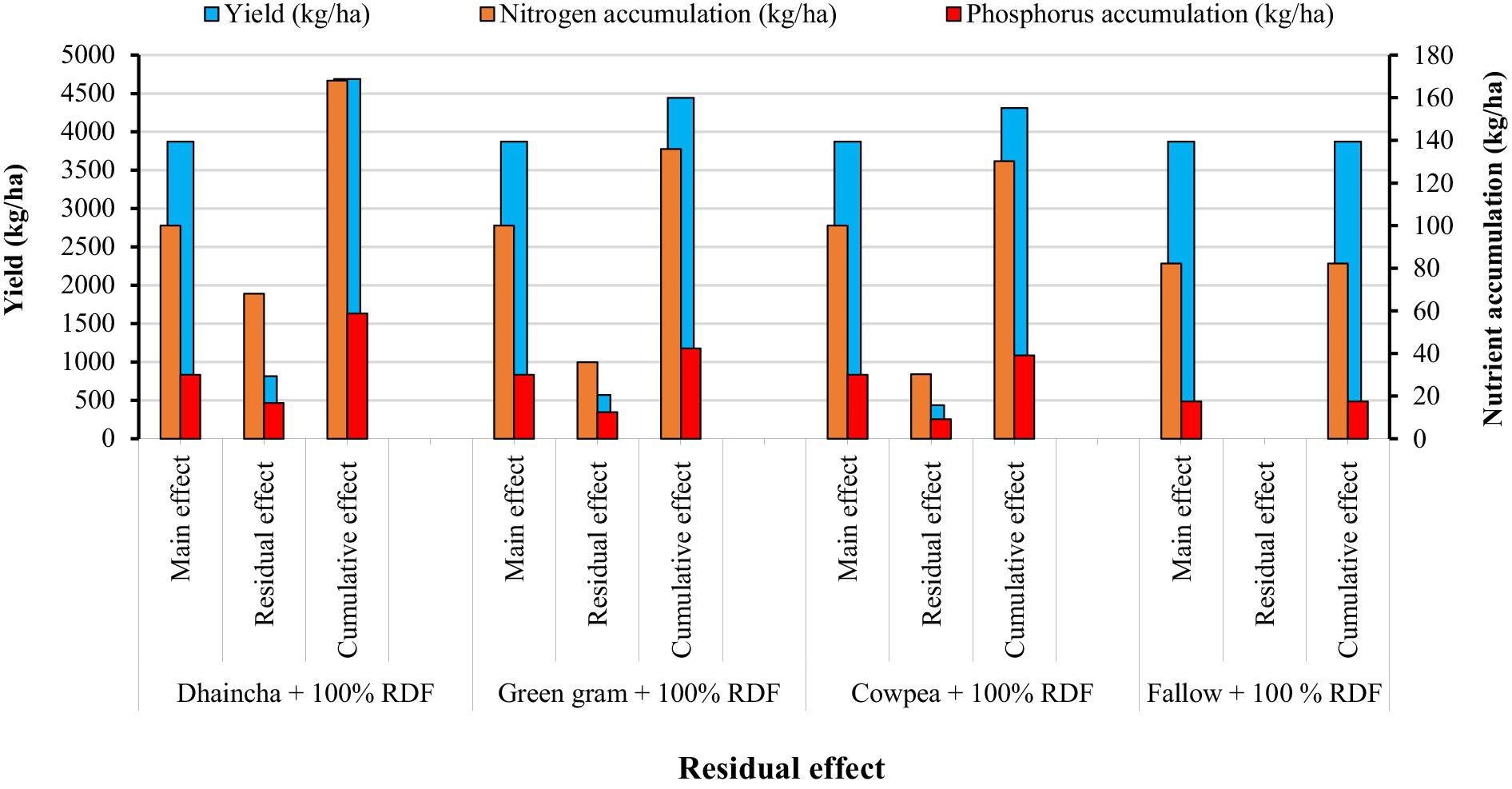
Figure 10. Residual effect of summer legumes on yield, nutrient accumulation of kharif rice as influenced by treatments.
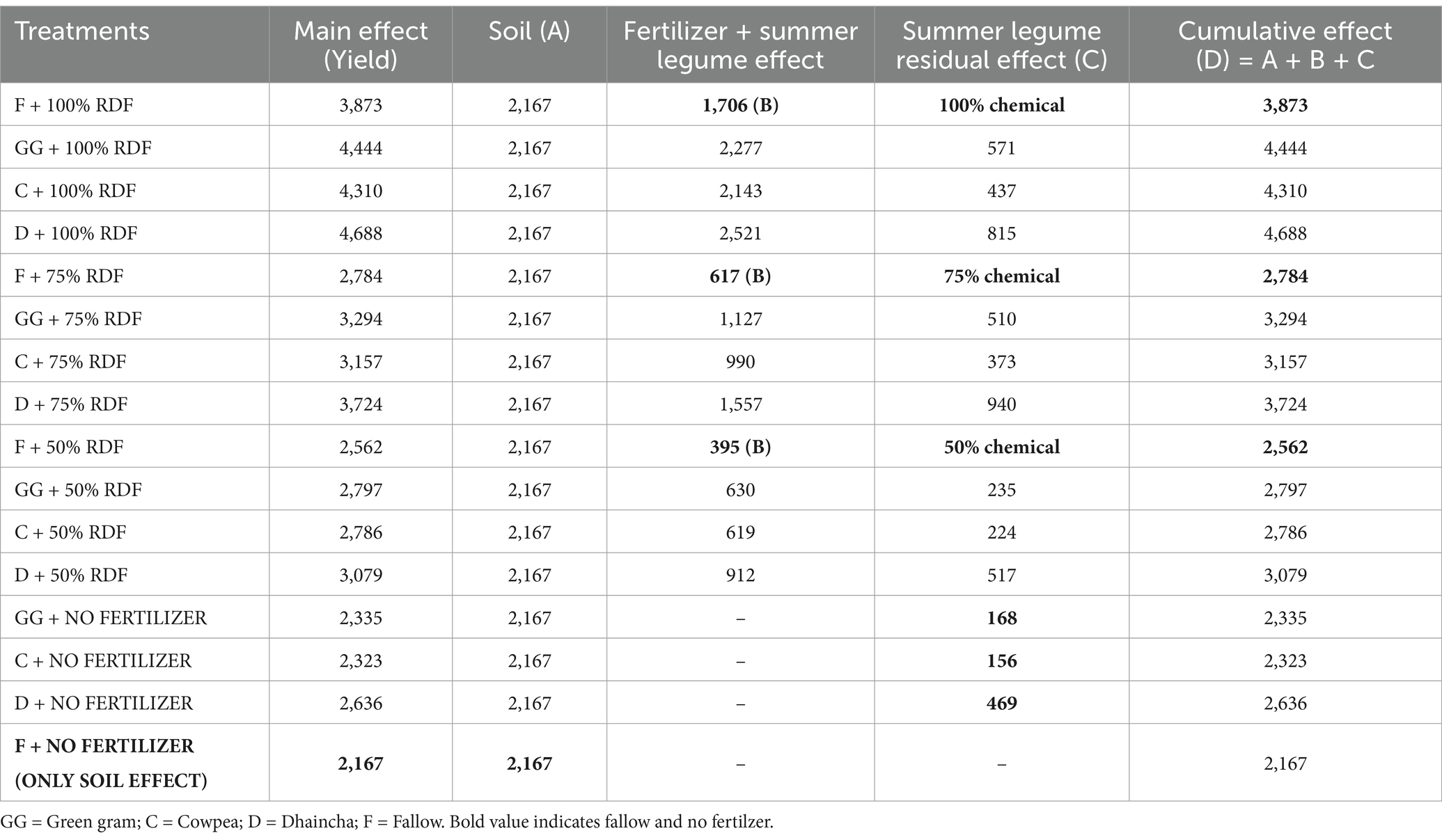
Table 13. Residual effect of summer legumes on yield of kharif rice as influenced by treatments (pooled basis).
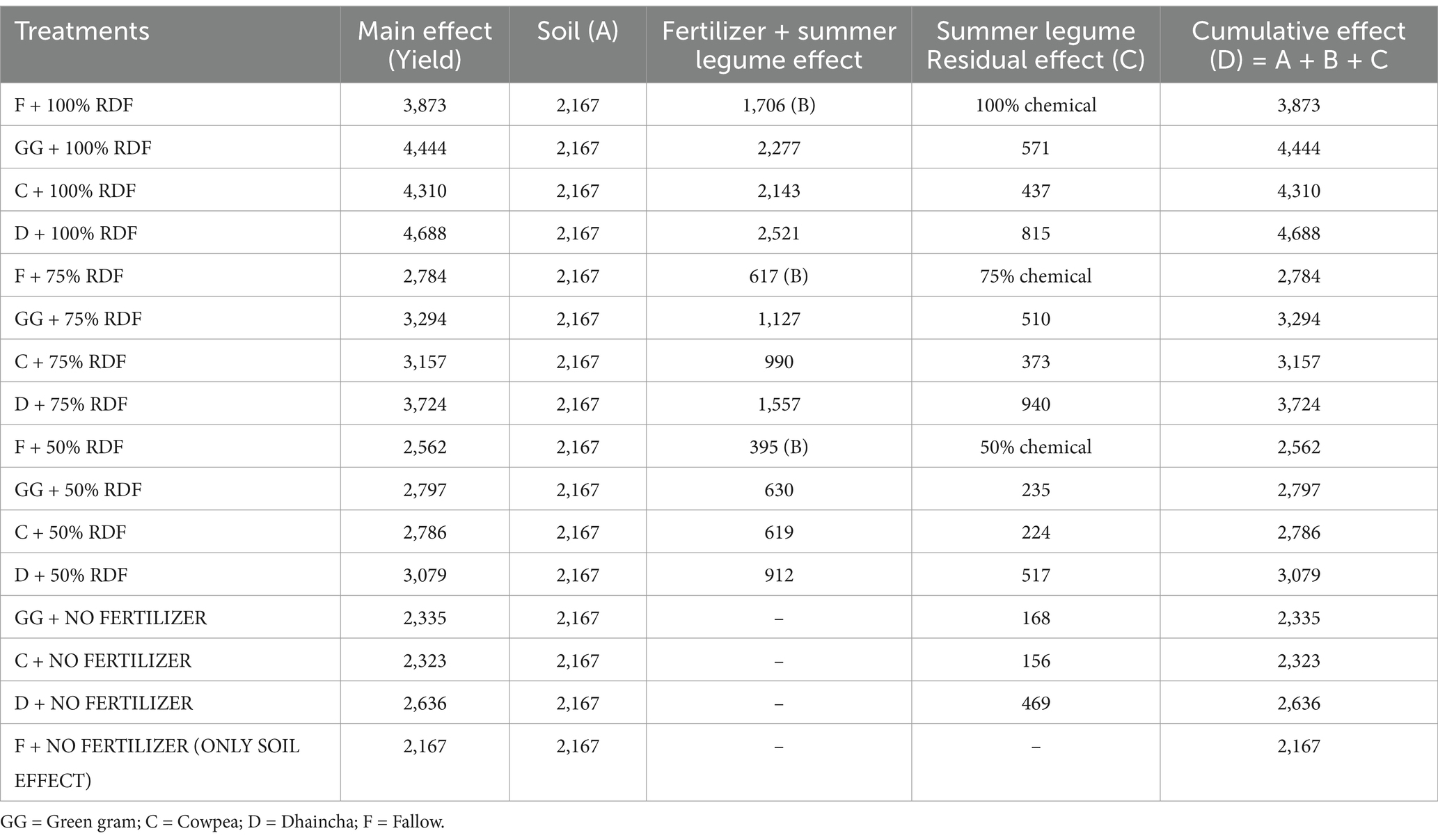
Table 14. Residual effect of summer legumes on yield of kharif rice as influenced by treatments (pooled).
6 Conclusion, recommendations and future study
Incorporation of summer legumes had no impact on organic carbon (%). Enhanced available N, P2O5 and K2O content of the soil after harvesting of the crop as compare to initial soil values. However, more increase in available N, P2O5 and K2O content was recorded under dhaincha incorporated plot. Nitrogen use efficiency, agronomic use efficiency was found higher in dhaincha incorporated plots applied with 100% RDF. Total uptake of NPK in rice plants was higher in dhaincha-100% RDF. Preceding summer legumes with residue incorporation could result in nitrogen economy for succeeding kharif, as it responded more in 100% RDF + dhaincha incorporation but at par with dhaincha + 75% RDF + 25% N from FYM. Exact quantification of nitrogen economy was not studied but the increment in yield and total nutrient uptake by rice when incorporated with dhaincha residues compared to fallow treatments gives an idea of residual effect of summer legumes and it may save an amount of 20–25% fertilizer approximately.
From this study, Dhaincha (Sesbania aculeata) incorporation in conjunction with 100% recommended dose of fertilizers (RDF) or 75% RDF + 25% N from FYM can be suggested to farmers to reduce synthetic fertilizer usage and achieving economic benefits.
Future study: To draw more robust and comprehensive conclusions, future research should focus on long-term studies that incorporate detailed carbon profiling, nutrient recycling, microbial assessments, and climate resilience to evaluate the broader ecological impacts. Additionally, precise quantification of nitrogen savings and an analysis of the economic implications would provide actionable insights for farmers.
Data availability statement
The original contributions presented in the study are included in the article/supplementary material, further inquiries can be directed to the corresponding authors.
Author contributions
TS: Conceptualization, Data curation, Formal analysis, Investigation, Methodology, Resources, Software, Validation, Writing – original draft, Writing – review & editing. HV: Conceptualization, Methodology, Project administration, Supervision, Validation, Writing – review & editing. KP: Conceptualization, Methodology, Writing – review & editing. MC: Formal analysis, Writing – original draft. MS: Data curation, Writing – review & editing. SM: Formal analysis, Funding acquisition, Writing – review & editing. AE: Writing – review & editing. AS: Formal analysis, Funding acquisition, Writing – review & editing. AEE: Data curation, Writing – review & editing. DE-S: Data curation, Writing – review & editing.
Funding
The author(s) declare that financial support was received for the research and/or publication of this article. This research was funded by Taif University, Saudi Arabia, Project No. (TU-DSPP-2024-53) & Open access funding provided by the University of Pécs, Hungary.
Acknowledgments
The authors extend their appreciation to Taif University, Saudi Arabia, for supporting this work through project number (TU-DSPP-2024-53), also, Special thanks to Navsari Agricultural University and farm manager for conducting of experiment and to all my co-authors.
Conflict of interest
The authors declare that the research was conducted in the absence of any commercial or financial relationships that could be construed as a potential conflict of interest.
Generative AI statement
The authors declare that no Gen AI was used in the creation of this manuscript.
Publisher’s note
All claims expressed in this article are solely those of the authors and do not necessarily represent those of their affiliated organizations, or those of the publisher, the editors and the reviewers. Any product that may be evaluated in this article, or claim that may be made by its manufacturer, is not guaranteed or endorsed by the publisher.
References
Agricultural Statistics at a Glance (2022). Economics & Statistics division, Department of Agriculture & farmers welfare. Government of India: Ministry of Agriculture & Farmers Welfare.
Alagappan, S., and Venkitaswamy, R. (2016). Performance of different sources of organic manures in comparison with RDF and INM on nutrient uptake, nutrient balance, and soil properties in rice-greengram cropping sequence. Int. J. Agril. Sci. 12, 326–334. doi: 10.15740/HAS/IJAS/12.2/326-334
Ammaji, P., and Rao, P. C. (2020). Effect of kharif legume crop residue incorporation in combination with nitrogen levels on growth and yield of succeeding maize during Rabi. Andhra Agric. J. 67, 7–11.
Baishya, L. K., Rathore, S. S., Singh, D., Sarkar, D., and Deka, B. C. (2015). Effect of integrated nutrient management on rice productivity, profitability and soil fertility. Ann. Plant Soil Res. 17, 86–90.
Bajpai, R. K., Chitale, S., Upadhyay, S. K., and Urkurkar, J. S. (2006). Long-term studies on soil physico-chemical properties and productivity of rice-wheat system as influenced by integrated nutrient management in Inceptisol of Chhattisgarh. J. Indian Soc. Soil Sci. 54, 24–29.
Balaji, A., Nilima, K., Kamlesh, P., Nitin, G., Ritesh, P., Ajay, N., et al. (2023). Study on dhaincha (Sesbania bispinosa) genotypes for N fxing capability and rate of mineralization under field and laboratory condition. Org. Agr. 13, 119–132. doi: 10.1007/s13165-022-00420-3
Balakrishnan, D., Bateman, N., and Kariyat, R. R. (2024). Rice physical defenses and their role against insect herbivores. Planta 259:110. doi: 10.1007/s00425-024-04381-7
Bharadwaj, A. K., Mailk, K., Rani, M., Mandal, U. K., Basak, N., Singh, A., et al. (2023). Residue recycling options and their implications for sustainable nitrogen management in rice–wheat agroecosystems. Ecol. Process 12:53. doi: 10.1186/s13717-023-00464-7
Bhattacharyya, R., Ghosh, B. N., Mishra, P. K., Mandal, B. P., Srinivasa Rao, C., Sarkar, D., et al. (2015). Soil degradation in India: challenges and potential solutions. Sustain. For. 7, 3528–3570. doi: 10.3390/su7043528
Bray, R. H., and Kurtz, L. T. (1945). Determination of total organic and available forms of phosphorus in soils. Soil Sci. 59, 39–46. doi: 10.1097/00010694-194501000-00006
Bremner, J. M. (1996). “Nitrogen Total” in Methods of soil analysis part 3: chemical methods, SSSA book series 5. ed. D. L. Sparks (Madison, Wisconsin: Soil Science Society of America), 1085–1122.
Chapman, H. D., and Brown, S. M. (1950). Analysis of organics leaves for diagnosing nutrient status with reference to potassium. Hilgardia, 19, 501–540.
Chen, S., Shaowen, L., Zheng, X., Yina, M., Chua, G., Xua, C., et al. (2018). Effect of various crop rotations on rice yield and nitrogen use efficiency in paddy–upland systems in southeastern China. Crop J. 6, 576–588. doi: 10.1016/j.cj.2018.07.007
Congreves, K. A., Olivia, O., Daphnée, F., Soudeh, F., Shanay, W., and Melissa, M. A. (2021). Nitrogen use efficiency definitions of today and tomorrow. Front. Plant Sci. 12:637108. doi: 10.3389/fpls.2021.637108
Geng, Y., Cao, G., Wang, L., and Wang, S. (2019). Effects of equal chemical fertilizer substitutions with organic manure on yield, dry matter, and nitrogen uptake of spring maize and soil nitrogen distribution. PLoS One 14:e0219512. doi: 10.1371/journal.pone.0219512
Ghosh, P. K., Bandyopadhyay, K. K., Wanjari, R. H., Manna, M. C., Misra, A. K., Mohanty, M., et al. (2007). Legume effect for enhancing productivity and nutrient use-efficiency in major cropping systems–an Indian perspective: a review. J. Sustain. Agric. 30, 59–86. doi: 10.1300/J064v30n01_07
Govindasamy, P., Muthusamy, S. K., Bagavathiannan, M., Mowrer, J., Jagannadham, P. T. K., Maity, A., et al. (2023). Nitrogen use efficiency—a key to enhance crop productivity under a changing climate. Front. Plant Sci. 14, 1–19. doi: 10.3389/fpls.2023.1121073
Guo, L. J., Zhang, Z. S., Wang, D. D., Li, C. F., and Cao, C. G. (2015). Effects of short-term conservation management practices on soil organic carbon fractions and microbial community composition under a rice-wheat rotation system. Biol. Fertil. Soils 50, 65–75.
Hepperly, P., Lotter, D., Ulsh Christine, Z., Seidel, R., and Reider, C. (2009). Compost, manure and synthetic fertilizer influences crop yields, soil properties, nitrate leaching and crop nutrient content. Compost Sci. Util. 17, 117–126. doi: 10.1080/1065657X.2009.10702410
Hu, B., Wang, W., Chen, J., Liu, Y., and Chu, C. (2023). Genetic improvement toward nitrogen use efficiency in rice: lessons and perspectives. Mol. Plant 16, 64–74. doi: 10.1016/j.molp.2022.11.007
Irin, I. J., Biswas, P. K., Ullah, M. J., Roy, T. S., and Khan, M. A. (2019). Influence of green manuring crops on dry matter production and soil health improvement. Bangladesh Agron. J. 22, 39–45.
Islam, M. R., Hossain, M. B., Siddique, A. B., Rahman, M. T., and Malika, M. (2014). Contribution of green manure incorporation in combination with nitrogen fertilizer in rice production. SAARC J. Agric. 12, 134–142. doi: 10.3329/sja.v12i2.21925
Islam, M. A., Sarkar, D., Alam, M. R., Jahangir, M. M. R., Ali, M. A., Sarker, D., et al. (2024). Legumes in conservation agriculture: a sustainable approach in rice-based ecology of the eastern Indo-Gangetic plain of South Asia − an overview. Technol. Agron. 3, 1–17. doi: 10.48130/TIA-2023-0003
Islam, M., Tahmina, A., Sohel, R., Saiful, A., and Moynul, H. M. (2019). Green manuring effects on crop morpho-physiological characters, rice yield and soil properties. Physiol. Mol. Biol. Plants 25, 303–312. doi: 10.1007/s12298-018-0624-2
Jackson, M. L. (1973). Soil and chemical analysis. New Delhi: Prentice Hall of India Private Limited.
Kamla, K., Gupta, C. S., and Paliyal, S. S. (2005). Effect of chemical fertilizers Vis-a-Vis organic manures (vermicompost, FYM) on wheat yield and soil health. Himachal J. Agril. Res. 31, 48–51.
Karklins, A., and Antons Ruza, A. (2015). Nitrogen apparent recovery can be used as the indicator of soil nitrogen supply. Zemdirbyste-Agriculture 102, 133–140. doi: 10.13080/z-a.2015.102.017
Kaur, R., Shivay, Y. S., Singh, G., Virk, H. K., Sen, S., and Rajni,. (2018). Increasing area under pulses and soil quality enhancement in pulse-based cropping systems-retrospect and prospects. Indian J. Agric. 88, 10–21.
Keniya, B. J., Zinzala, V. J., and Sisodiya, R. R. (2024). Assessment of soil physico-chemical properties in sugarcane cultivation areas of Navsari District, Gujarat, India. Asian J. Soil Sci. Plant Nutr. 10, 13–20. doi: 10.9734/ajsspn/2024/v10i4377
Knudsen, D., Paterson, G. A., and Pratt, P. F. (1982). Lithium, sodium and potassium. In: A. L. Page (ed.) Methods of Soil Analysis. Part 2, 2nd edn. Agronomy No. 9. (Madison, WI: American Society of Agronomy), pp. 225–246.
Kouelo, F. A., Pascal, H., and Dercon, G. (2013). Contribution of seven legumes residues incorporated into soil and NP fertilizer to maize yield, nitrogen use efficiency and harvest index in degraded soil in the center of Benin. Int. J. Biol. Chem. Sci. 7, 2468–2489.
Kumar, V., Tripathi, H. C., and Mishra, S. K. (2012). Influence of integrated nutrient management on yield, economics, and nutrient uptake of hybrid rice (Oryza sativa L.). New Agriculturist 23, 117–121.
Kumari, N., Pal, S. K., and Barla, S. (2013). Effect of organic nutrient management on productivity and economics of scented rice. Oryza 50, 249–252.
Ladha, J. K., Peoples, M. B., Reddy, P. M., Biswas, J. C., Bennett, A., Jat, M. L., et al. (2022). Biological nitrogen fixation and prospects for ecological intensification in cerealbased cropping systems. Field Crop Res. 283:108541. doi: 10.1016/j.fcr.2022.108541
Lou, Y., Xu, M., Wang, W., Sun, X., and Zhao, K. (2011). Return rate of straw residue affects soil organic C sequestration by chemical fertilization. Soil Tillage Res. 113, 70–73. doi: 10.1016/j.still.2011.01.007
Mahajan, G., Kumar, V., and Chauhan, B. S. (2017). “Rice production in India” in Rice production worldwide. Springer publications, 53–91.
Maiti, S., Saha, M., Banerjee, H., and Pal, S. (2006). Integrated nutrient management under hybrid rice (Oryza sativa) - hybrid rice cropping sequence. Indian J. Agron. 51, 157–159.
Mangaraj, S., Paikaray, R. K., Garnayak, L. M., Behera, S. D., Patra, B., Sethi, D., et al. (2023). Crop and soil productivity of a rice-green gram system under integrative nutrient management. Agron. J. 115, 2631–2645. doi: 10.1002/agj2.21401
Maobe, S. N., Akundabweni, L. S. M., Mburu, M. W. K., Ndufa, J. K., Mureithi, J. G., Gachene, C. K. K., et al. (2011). Effect of Mucuna green manure application rate on decomposition and soil available nitrogen under field conditions: I. During season of incorporation. World J. Agric. Sci. 7, 430–438.
Meng, X., Li, Y., Zhang, Y., and Yao, H. (2019). Green manure application improves rice growth and urea nitrogen use efficiency assessed using 15N labeling. Soil Sci. Plant Nutr. 65, 511–518. doi: 10.1080/00380768.2019.1635872
Morre, K. P. (1991). Determination of phosphorus in plant tissue by colorimetry. In: Plant Analysis Reference Procedures for the Southern Region of the United States, C. O. Plank (ed). Southern Cooperative Bull, 368, (Athens, GA: University of Georgia). pp. 29–32.
Muschietti-Piana, P., McBeath, T. M., McNeill, A. M., Cipriotti, P. A., and Gupta, V. V. S. R. (2020). Combined nitrogen input from legume residues and fertilizer improves early nitrogen supply and uptake by wheat. J. Plant Nutr. Soil Sci. 183, 355–366. doi: 10.1002/jpln.202000002
Naher, U. A., Choudhury, T. M. A., Biswas, J. C., Qurban, A. P., and Ivan, R. K. (2019). Prospects of using leguminous green manuring crop Sesbania rostrata for supplementing fertilizer nitrogen in rice production and control of environmental pollution. J. Plant Nutr. 43, 1532–4087. doi: 10.1080/01904167.2019.1672734
Nath, C. P., Kumar, N., Dutta, A., Hazra, K. K., Praharaj, C. S., Singh, S. S., et al. (2023). Pulse crop and organic amendments in cropping system improve soil quality in rice ecology: evidence from a long–term experiment of 16 years. Geoderma 430:116334. doi: 10.1016/j.geoderma.2023.116334
Nawaz, A., Farooq, M., Lal, R., Rehman, A., Hussain, T., and Nadeem, A. (2017). Influence of sesbania brown manuring and rice residue mulch on soil health, weeds and system productivity of conservation rice–wheat systems. Land Degrad. Dev. 28, 1078–1090. doi: 10.1002/ldr.2578
Pan, Y., Guo, J., Fan, L., Ji, Y., Liu, Z., Wang, F., et al. (2022). The source–sink balance during the grain filling period facilitates rice production under organic fertilizer substitution. Eur. J. Agron. 134:126468. doi: 10.1016/j.eja.2022.126468
Pandey, N., and Verma, A. K. (2007). Integrated nutrient management in transplanted hybrid rice (Oryza sativa). Indian J. Agron. 52, 40–42.Anurag and Tripathi, R.S
Panse, V. G., and Sukhatme, P. V. (1967). Statistical methods for agricultural workers. New Delhi: Indian Council of Agricultural Research, 145–152.
Pathak, H., Nayak, A. K., Jena, M., Singh, O. N., Samala, P., and Sharma, S. G. (2018). Rice research for enhancing productivity, profitability and climate resilience. Cuttack, Odisha, India: ICAR-National Rice Research Institute, 542.
Peoples, M., Swan, A., Goward, L., Kirkegaard, J., Hunt, J., Li, G., et al. (2017). Soil mineral nitrogen benefits derived from legumes and comparisons of the apparent recovery of legume or fertiliser nitrogen by wheat. Soil Res. 55:600. doi: 10.1071/SR16330
Pooniya, V., and Shivay, Y. S. (2012). Effect of green manuring and zinc fertilization on productivity and nutrient uptake in basmati rice (Oryza sativa L.)-wheat (Triticum aestivum) cropping system. Indian J. Agron. 56, 28–34. doi: 10.59797/ija.v56i1.4665
Puli, M. R., Prasad, P. R. K., Ravindra, P. B., Jayalakshmi, M., and Burla, S. R. (2016). Effect of organic and inorganic sources of nutrients on rice crop. Oryza 53, 151–159.
Rani, Y. S., Jamuna, P., Triveni, U., Patro, T. S. S. K., and Anuradha, N. (2022). Effect of in situ incorporation of legume green manure crops on nutrient bioavailability, productivity and uptake of maize. J. Plant Nutr. 45, 1004–1016. doi: 10.1080/01904167.2021.2005802
Rao, A. C. S., Smith, J. L., Parr, J. F., and Papendick, R. I. (1992). Considerations in estimating nitrogen recovery efficiency by the difference and isotopic dilution methods. Fertilizer Res. 33, 209–217. doi: 10.1007/BF01050876
Regassa, H., Elias, E., Tekalign, M., and Legese, G. (2023). The nitrogen fertilizer replacement values of incorporated legumes residue to wheat on vertisols of the Ethiopian highlands. Heliyon 9:e22119. doi: 10.1016/j.heliyon.2023.e22119
Russel, B. J., and Ginn, J. S. (2004). Practical handbook of soil, vadose zone and ground water contamination: assessment, prevention and remediation. 2nd Edn Lewis publishers, 691.
Saraswat, P. K., Kumar, K., Tiwari, R. C., and Singh, V. K. (2010). Influence of different summer green manures on rice–wheat yield, nutrient uptake, and soil characteristics. J. Hill Agric. 1, 23–29.
Sarkar, D., Sankar, S., Siva, D. O., Sonam, S., Shikha,, Manoj, P., et al. (2021). Optimizing nutrient use efficiency, productivity, energetics, and economics of red cabbage following mineral fertilization and biopriming with compatible rhizosphere microbes. Sci. Rep. 11:15680. doi: 10.1038/s41598-021-95092-6
Sharma, A. R., and Ghosh, A. (2000). Effect of green manuring with Sesbania aculeate and nitrogen fertilization on the performance of direct-seeded flood-prone lowland rice. Nutr. Cycle Agroecosyst. 57, 141–153. doi: 10.1023/A:1009863100224
Singh, R. B. (2000). Environmental consequences of agricultural development: a case study from the green revolution state of Haryana, India. Agricult. Ecosyst. Environ. 82, 97–103. doi: 10.1016/S0167-8809(00)00219-X
Singh, F., Ravindra, K., and Samir, P. (2008). Integrated nutrient management in rice-wheat cropping system for sustainable productivity. J. Indian Soc. Soil Sci. 56, 205–208.
Singh, B., Sidhu, G. S., and Singh, V. (2024). Effect of moong bean as green manuring and residue incorporation on growth, productivity of basmati rice. Int. J. Res. Agron. 7, 323–326. doi: 10.33545/2618060X.2024.v7.i2e.323
Song, S., Lin, L., Yin, Q., and Nie, L. (2022). Effect of in situ incorporation of three types of green manure on soil quality, grain yield and 2-acetyl-1-pyrrolline content in tropical region. Crop Environ. 1, 189–197. doi: 10.1016/j.crope.2022.08.005
Stagnari, F., Maggio, A., Galieni, A., and Pinate, M. (2017). Multiple benefits of legumes for agriculture sustainability. Chem. Biol. Technol. Agric. 4, 3–13. doi: 10.1186/s40538-016-0085-1
Stangel, P. J. (1991). Presentation in the international workshop on evaluation for sustainable land management in the developing world, Chiangrai, Thailand. Bangkok, TH: International Board for Soil Research and Management.
Subbiah, B. V., and Asija, G. L. (1956). A rapid procedure for the determination of available nitrogen in soil. Curr. Sci. 25, 259–260.
Sunil Kumar, T., Virdia, H. M., Patel, K. G., Ragi, S., Chowdhury, M., Kumar, P., et al. (2024). Effect of summer legume residue incorporation and fertilizer regimes on rice growth, yield, and nutrient uptake. Front. Sustain. Food Syst. 8:1467201. doi: 10.3389/fsufs.2024.1467201
Sunitha, B. P., Prakasha, H. C., and Gurumurthy, K. T. (2010). Effect of INM approach on soil physical properties, available nutrient status, concentration, and their uptake by rice crop in Bhadra Command, Karnataka. Mysore J. Agric. Sci. 44, 905–910.
Talathi, M. S., Pinjari, S. S., Ranshur, N. J., Bhondave, T. S., and Suryawanshi, J. S. (2009). Response of hybrid rice (Oryza sativa L.) to green leaf manure, FYM and chemical fertilizers. Int. J. Agricult. Sci. 5, 501–506.
Tarafdhar, J. C., Nandy, P., and Das, S. K. (2016). Effect of integrated nutrient management and foliar spray of zinc in nanoform on rice crop nutrition, productivity and soil chemical and biological properties in inceptisols. J. Soil Sci. Plant Nutr. 23, 540–555.
Thulasi, V., Moosa, P. P., Santosh, P. P., Drishya, D. S., Nisha, N. S., and Raji, P. (2024). Green manuring – a cost effective and farmer friendly alternative for farm. Yard Manure J. Krishi Vigyan 12, 285–291. doi: 10.5958/2349-4433.2024.00081.0
Upadhyay, V. B., Jain, V., Vishwakarma, S. K., and Kumar, A. K. (2011). Production potential, soil health, water productivity and economics of rice (Oryza sativa) – based cropping systems under different nutrient sources. Indian J. Agron. 56, 311–316.
Vaziritabar, Y., Frei, M., Yan, F., Vaziritabar, Y., and Honermeier, B. (2024). Enhancing nitrogen use efficiency and plant productivity in long-term precrop/crop rotation and fertilization management. Field Crop Res. 306:109210. doi: 10.1016/j.fcr.2023.109210
Walia, S. S., Dhaliwal, S. S., Gill, R. S., Kaur, T., Kaur, K., Randhawa-Obrocnik, O., et al. (2024). Improvement of soil health and nutrient transformations under balanced fertilization with integrated nutrient management in a rice-wheat system in Indo-Gangetic Plains – a 34-year research outcomes. Heliyon 10:e25113. doi: 10.1016/j.heliyon.2024.e25113
Walkley, A., and Black, I. A. (1934). An examination of the Degtijareff method for determining soil, organic matter and proposed modification of the chromic acid titration method. Soil Sci. 34, 29–38.
Xia, L., Lam, S. K., Wolf, B., Kiese, R., Chen, D., and Butterbach-Bahl, K. (2018). Trade-offs between soil carbon sequestration and reactive nitrogen losses under straw return in global agroecosystems. Glob. Chang. Biol. 24, 5919–5932. doi: 10.1111/gcb.14466
Yadav, L., and Meena, N. (2014). Performance of aromatic rice (Oryza sativa) genotype as influenced by integrated nitrogen management. Indian J. Agron. 59, 51–255.
Yang, L., Zhou, X., Liao, Y., Lu, Y., Nie, J., and Cao, W. (2019). Co-incorporation of rice straw and green manure benefits rice yield and nutrient uptake. Crop Sci. 59, 749–759. doi: 10.2135/cropsci2018.07.0427
Ye, L., Zhao, X., Bao, E., Li, J., Zou, Z., and Cao, K. (2020). Bio-organic fertilizer with reduced rates of chemical fertilization improves soil fertility and enhances tomato yield and quality. Sci. Rep. 10, 1–11. doi: 10.1038/s41598-019-56954-2
Zhao, N., Bai, L., Han, D., Yao, Z., Liu, X., Hao, Y., et al. (2024). Combined application of leguminous green manure and straw determined grain yield and nutrient use efficiency in wheat–maize–sunflower rotations system in Northwest China. Plan. Theory 13:1358. doi: 10.3390/plants13101358
Zhao, T., He, A., Khan, M. N., Yin, Q., Song, S., and Nie, L. (2024). Coupling of reduced inorganic fertilizer with plant-based organic fertilizer as a promising fertilizer management strategy for colored rice in tropical regions. J. Integr. Agric. 23, 93–107. doi: 10.1016/j.jia.2023.04.035
Zhou, G., Cao, W., Bai, J., Xu, C., Zeng, N., Gao, S., et al. (2019). Non-additive responses of soil C and N to rice straw and hairy vetch (Vicia villosa Roth L.) mixtures in a paddy soil. Plant Soil 436, 229–244. doi: 10.1007/s11104-018-03926-6
Keywords: nutrient use efficiency, apparent recovery ratio, soil nutrient, nutrient uptake, rice
Citation: Sunil Kumar T, Virdia HM, Patel KG, Chowdhury M, Satya MSSC, Mahmoud SF, Elbeltagi A, Salem A, Elwakeel AE and El-Shinawy DM (2025) Residual effect of summer legumes incorporation on soil nutrient status and nutrient use efficiency of kharif rice. Front. Sustain. Food Syst. 9:1535162. doi: 10.3389/fsufs.2025.1535162
Edited by:
Manosh Kumar Biswas, University of Leicester, United KingdomReviewed by:
Kanu Murmu, Bidhan Chandra Krishi Viswavidyalaya, IndiaSiddhartha Mukherjee, Ramakrishna Mission Vivekananda Educational and Research Institute, India
Copyright © 2025 Sunil Kumar, Virdia, Patel, Chowdhury, Satya, Mahmoud, Elbeltagi, Salem, Elwakeel and El-Shinawy. This is an open-access article distributed under the terms of the Creative Commons Attribution License (CC BY). The use, distribution or reproduction in other forums is permitted, provided the original author(s) and the copyright owner(s) are credited and that the original publication in this journal is cited, in accordance with accepted academic practice. No use, distribution or reproduction is permitted which does not comply with these terms.
*Correspondence: Tamminaina Sunil Kumar, c3VuaWx0YW1taTcwODJAZ21haWwuY29t; Manojit Chowdhury, bWFub2ppdGNob3dkaHVyeTEzQGdtYWlsLmNvbQ==; Ali Salem, c2FsZW0uYWxpQG1pay5wdGUuaHU=
 Tamminaina Sunil Kumar1*
Tamminaina Sunil Kumar1* Manojit Chowdhury
Manojit Chowdhury Ahmed Elbeltagi
Ahmed Elbeltagi Ali Salem
Ali Salem